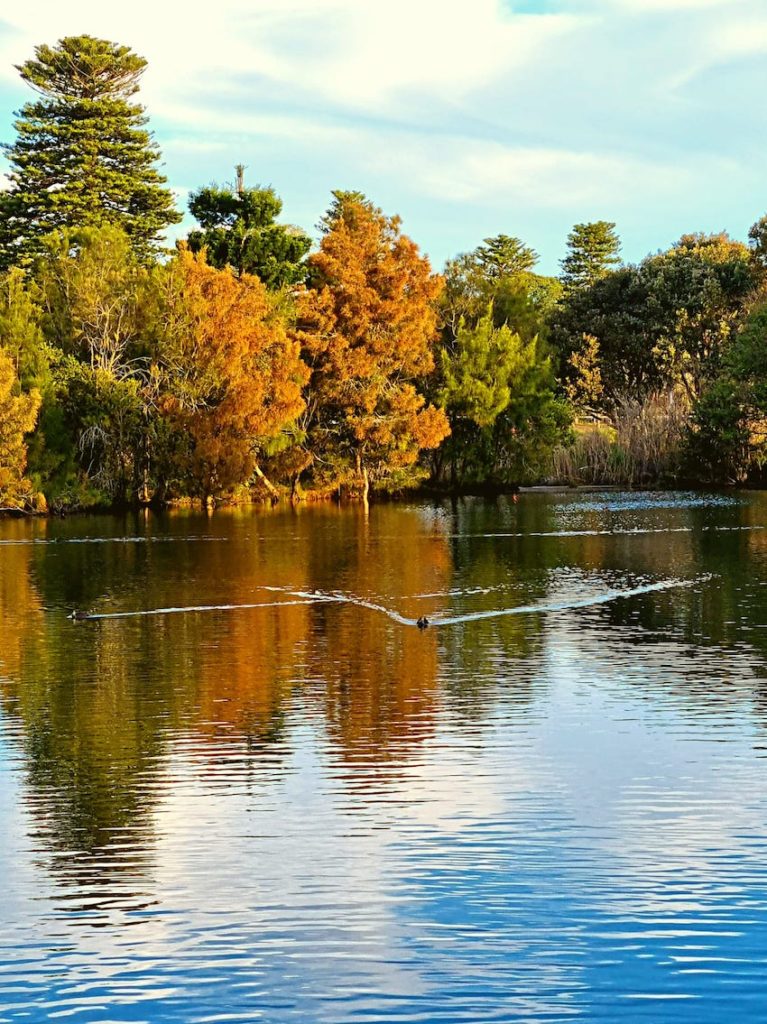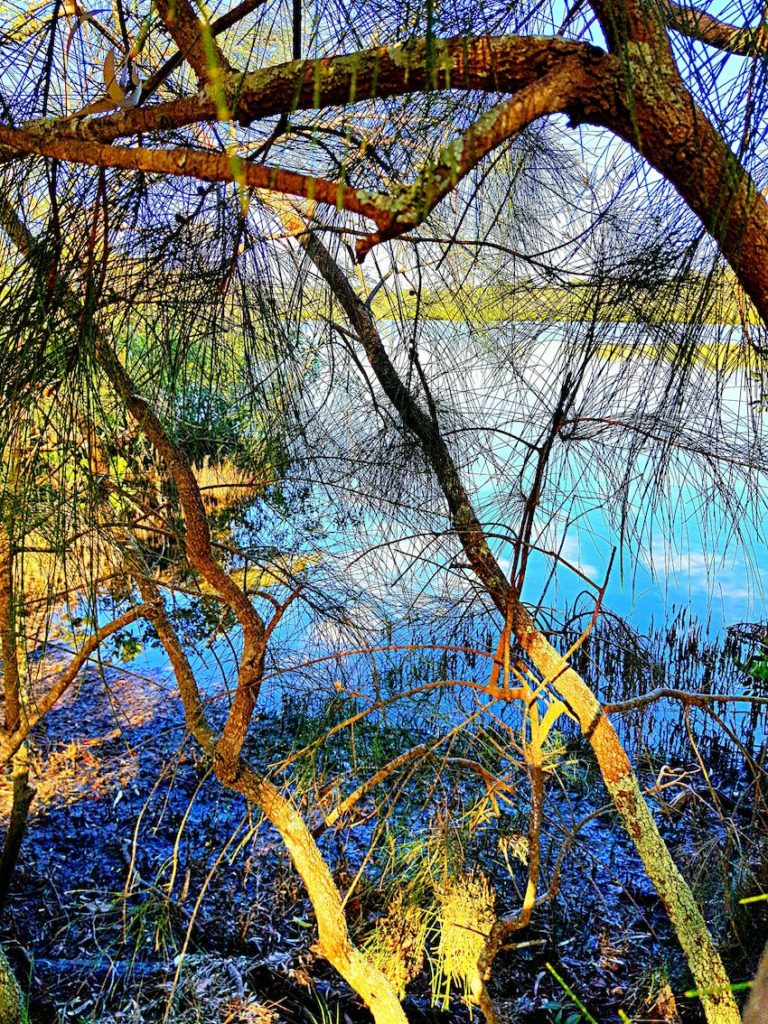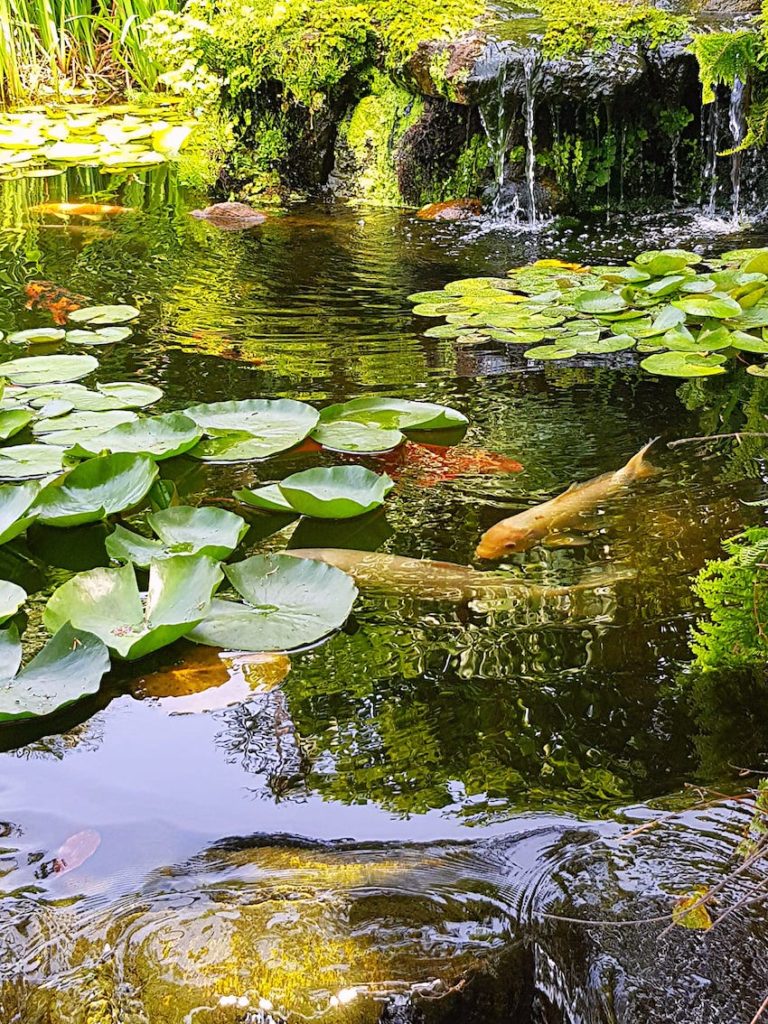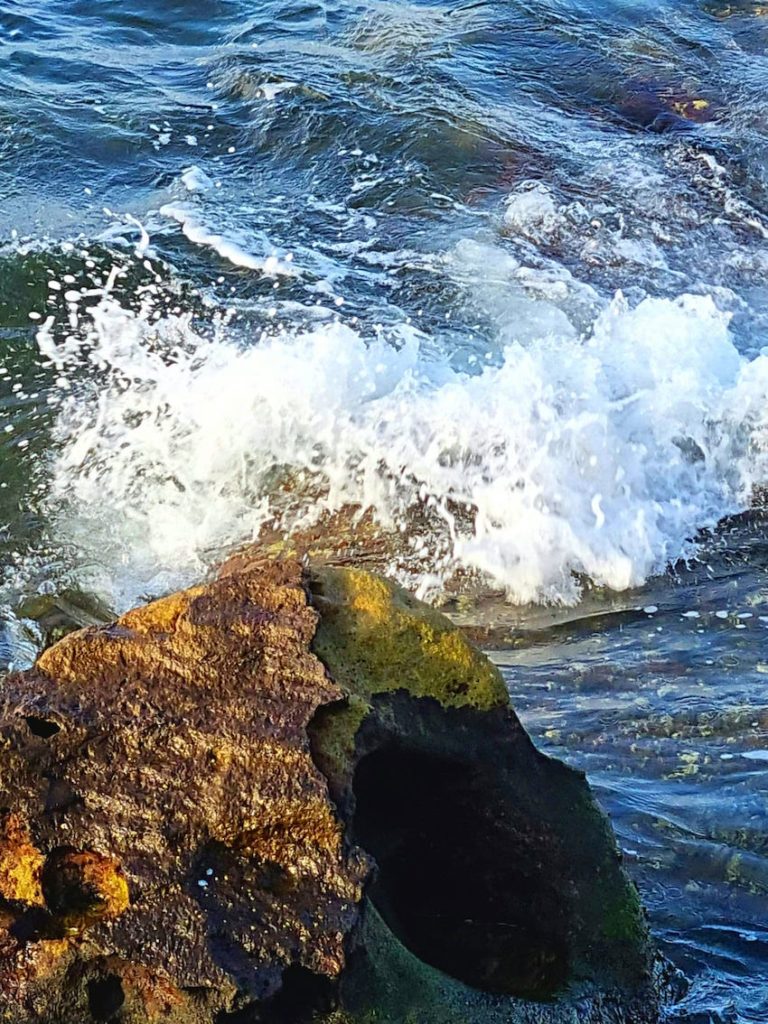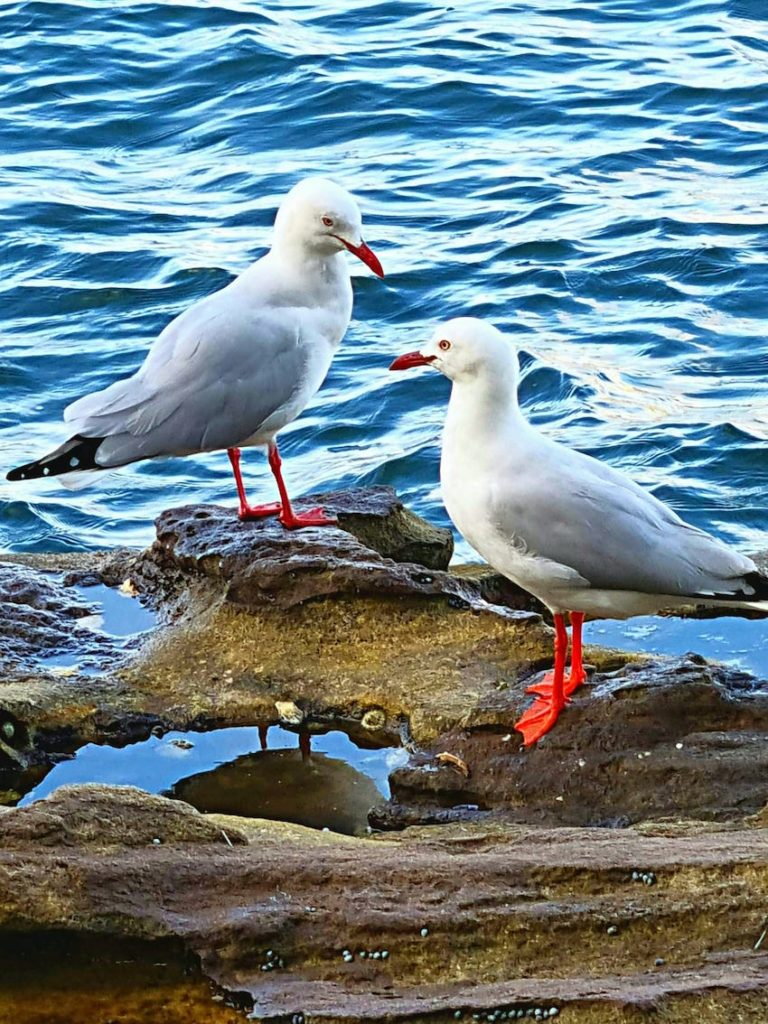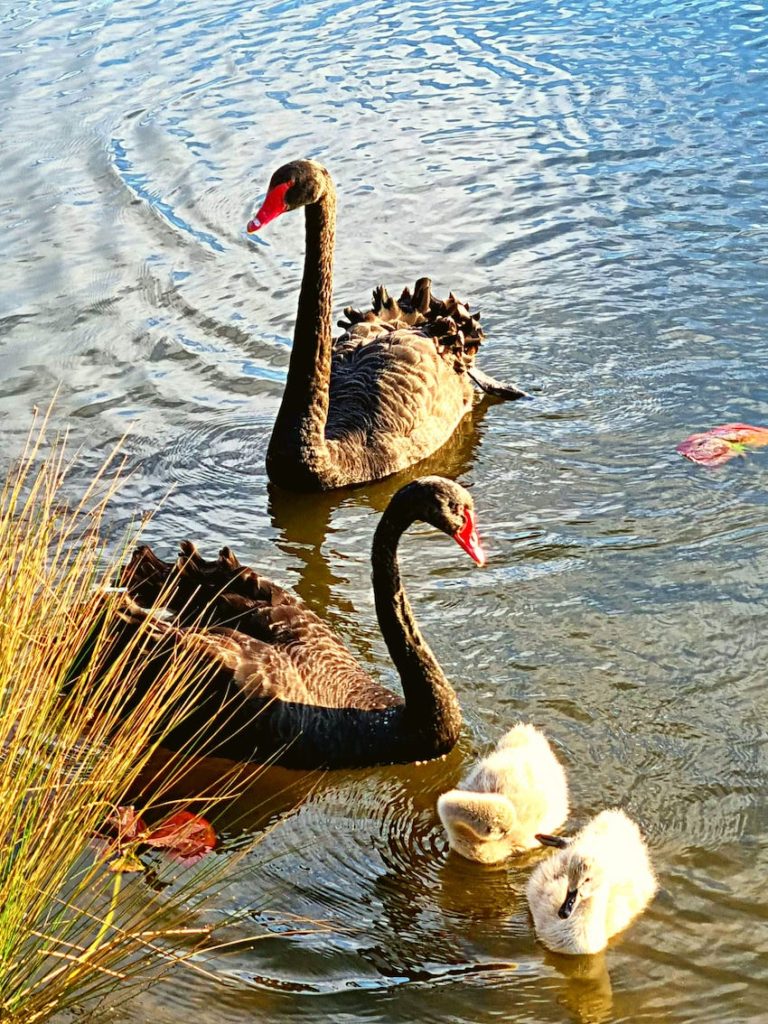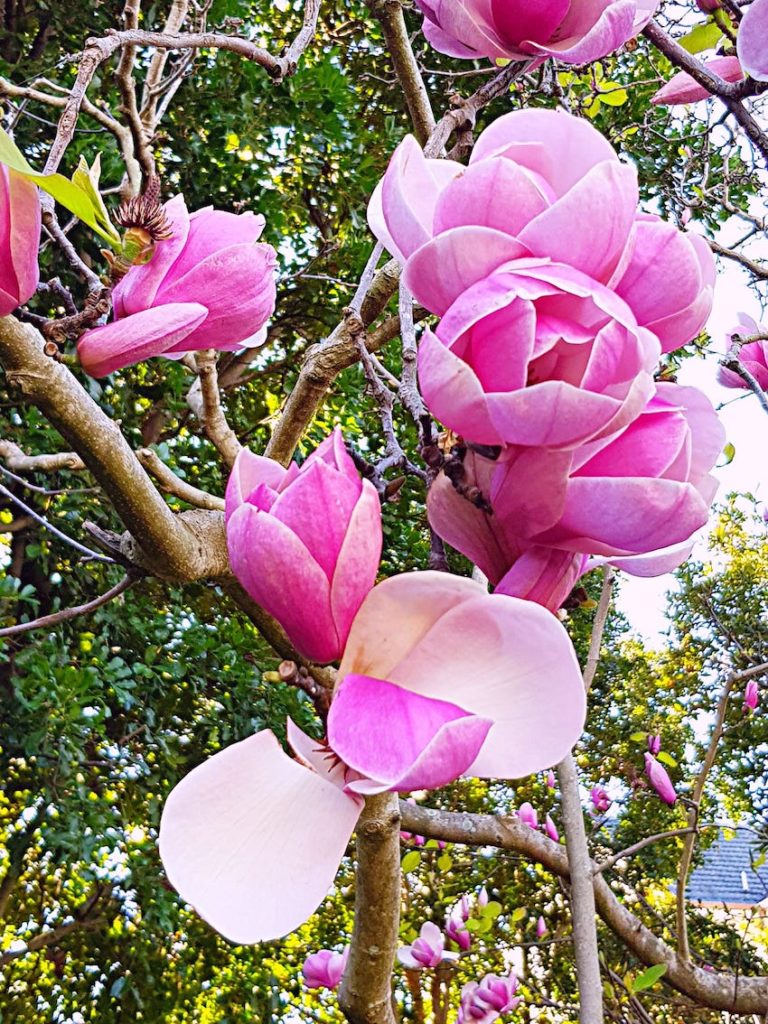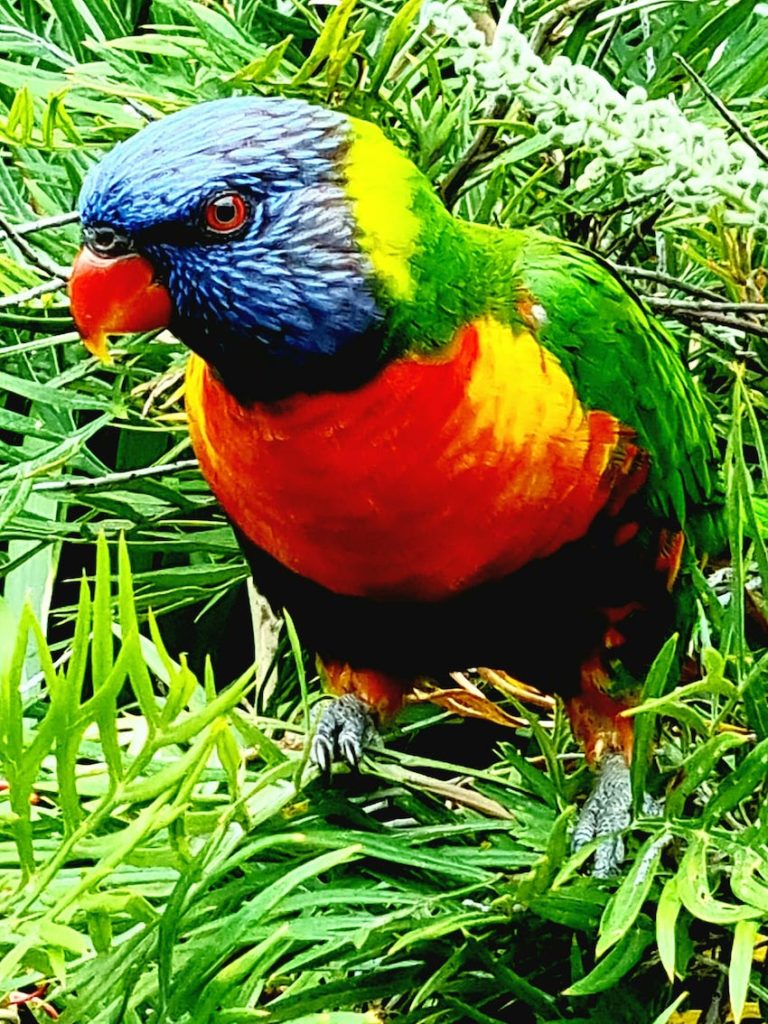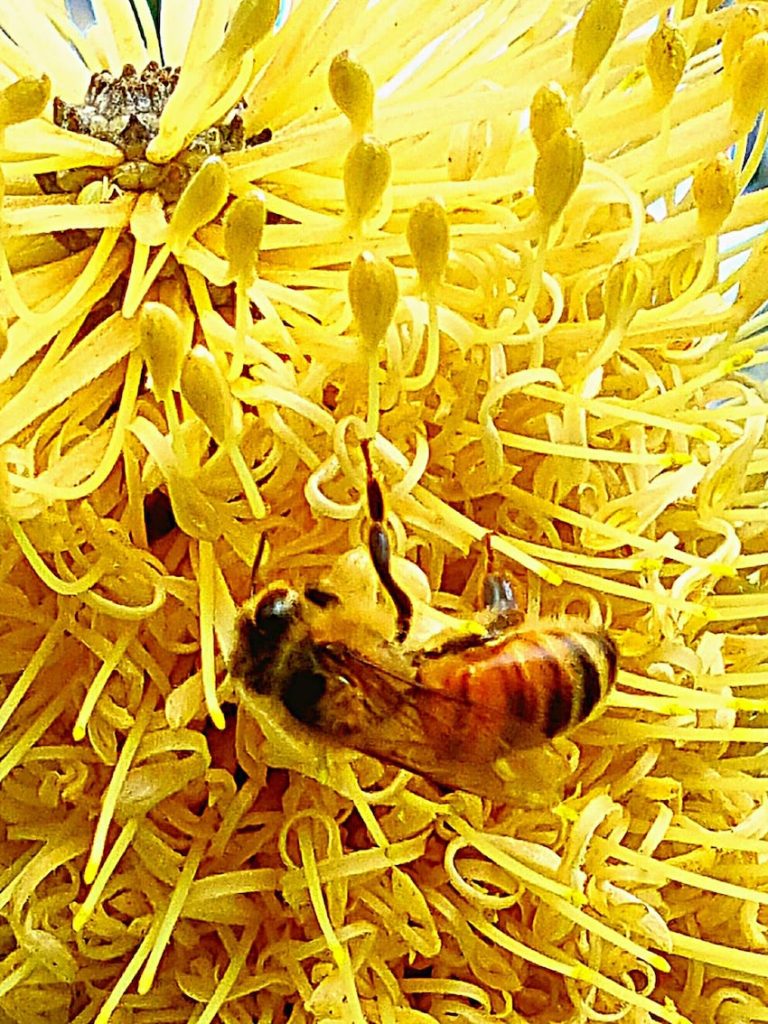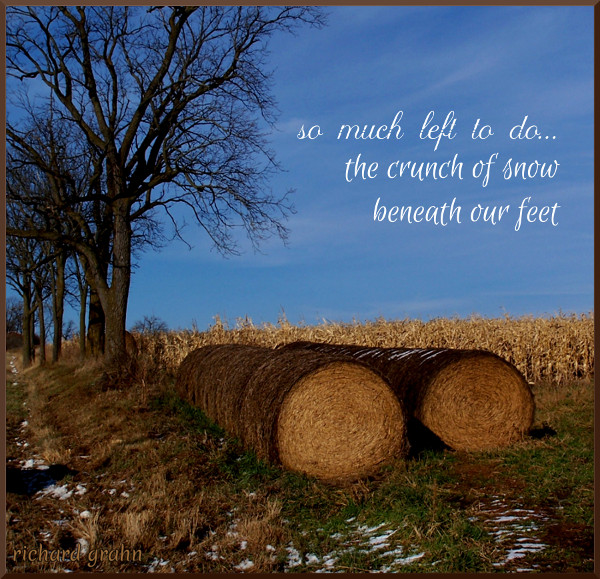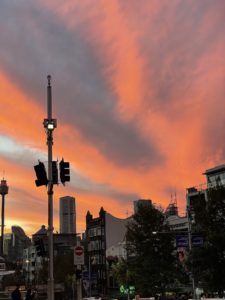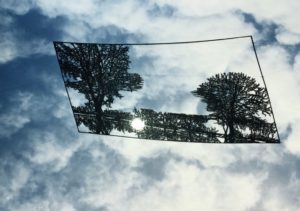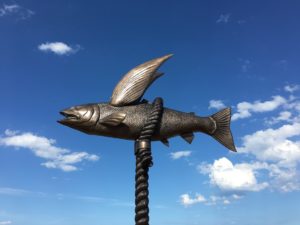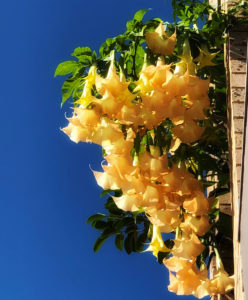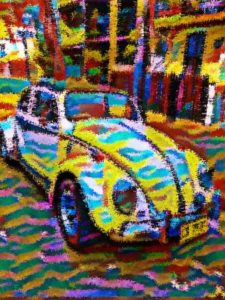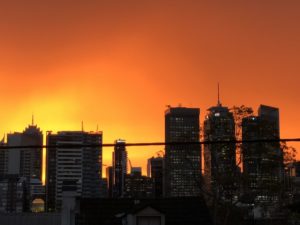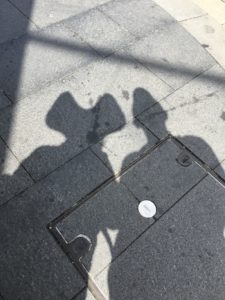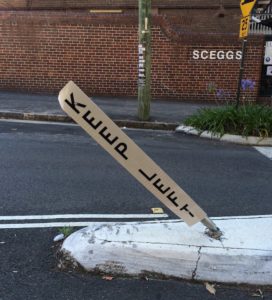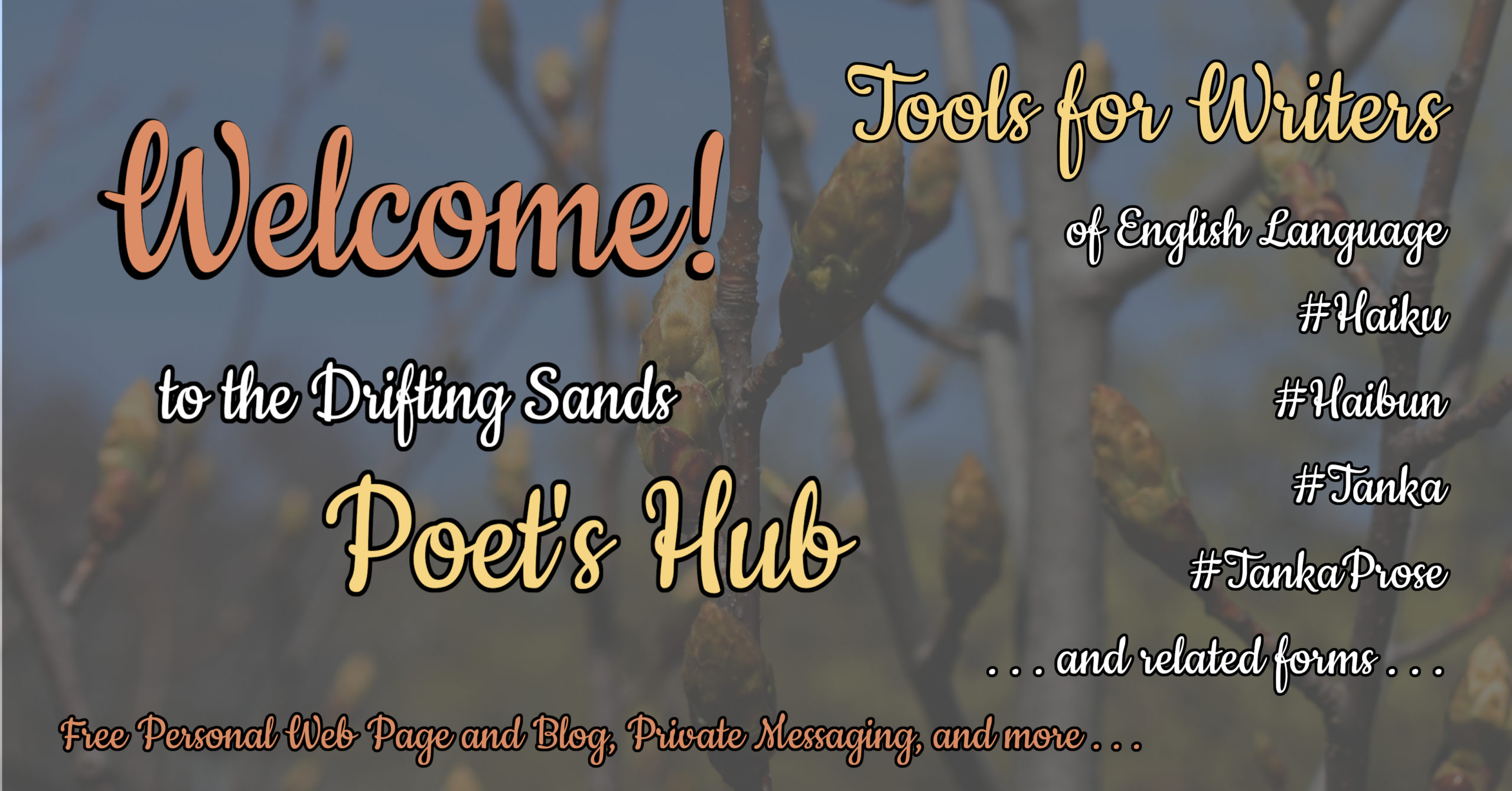
-
All Poet Pages
Hello, thanks for dropping by. I’m Clive by the way, sometime philosopher, thinker, dreamer, birdwatcher, poet, and occasional writer. Living and writing in beautiful North Wales.
still waters a frog jumps ... into my reflection
I’ve been watching birds for as long as I can remember but only started writing haiku about birds a few years ago – drawing inspiration direct from nature and my memories, but also from paintings of birds, and their songs, and from the writings and essays of some of our greatest English Nature Writers and Poets, notably Richard Jefferies and W H Hudson.
Here’s one of my first and favourite haiku …
swift scream
down cobbled streets
bikers follow
My haiku have been published in the Wales Haiku Journal, Presence, Hedgerow, Blo͞o Outlier Journal, ‘Failed Haiku’, tsuri-dōrō journal, and most recently in the Scarlet Dragonfly Journal. Here’s a few …
up in the attic
crawling through
my childhood
Wales Haiku Journal Summer 2021
sunshine filling every room the cuckoo’s call
Presence Issue 68
primroses in the hedgerow bank a robin’s nest
Hedgerow #134 Spring 2021
waking up
... next to you
waking up
flower moon
her scent of jasmine
in every room
‘Failed Haiku’ - A Journal of English Senryu Volume 6, Issue 67
daytime moon
the ebb and flow
of sanderlings
The Inaugural edition of Scarlet Dragonfly Journal (April 2022)
I’m indebted to some exceptional haijin who have knowingly or unknowingly helped me along the way – Paul Chambers, Founding Editor of the Wales Haiku Journal, Colin Blundell, Former President of the British Haiku Society and fellow enthusiast of Richard Jefferies, and Alan Summers, President of United Haiku and Tanka Society. Not forgetting Joe Woodhouse the current editor of the Wales Haiku Journal and Caroline Skanne Founding Editor of Hedgerow – a Journal of Small Poems. And of course to every poet who has ever published and shared their work
My occasional thoughts, poems and other scribblings can be found in my Blog here: Blog Posts. Or you can catch up with me on Twitter. If you’re into Podcasts then you can listen to me reading some of my poems by following the link My Podcasts . And please don’t be shy on leaving a comment – I’d love to hear from you …
![]()
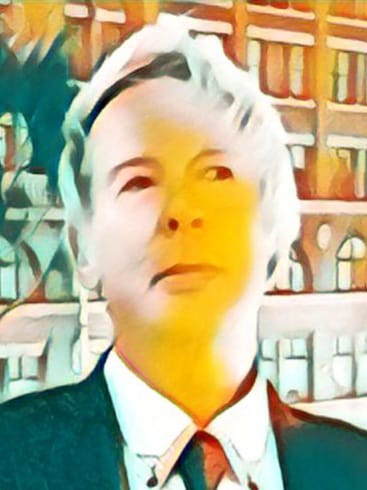
I am a member of the Australian Haiku Society, a Writing Fellow of the FAW NSW Inc., and an occasional co-editor of Echidna Tracks – Australian Haiku. The Drifting Sands Special Feature, Girt by Sea was my undertaking; the partnership of my photography and poetry from Australian writers. I hope you have had a chance to explore this special feature.
I currently have two published poetry collections: Shadow Play, Dragonwick, Aus., and changing light, Alba Publishing, UK.
There are many people that have assisted me on my writing journey; from my first attempts at free verse poetry and prose, to the subsequent discovery of haiku and its related forms.
Australian author Jack Radley, the great uncle of a friend, first caused me to become serious about writing. Encouraging me to write short fiction and poetry, Jack was delighted when I began to have success in competitions, or work was accepted for publication. However, Jack’s honest critique of my prose was that I tended to overwrite. In his words, he sometimes had to ‘move the furniture to see the room’. Years later he admitted to having worried that he had been too hard on me. I assured him he had been tough but fair, and that I had taken heart from his continued encouragement. He remained a dear friend and mentor up until his death in 2008. To this day I miss him terribly.
In 2000 I enrolled in a creative writing course with Australian writer, Kate Walker, who has also been an influence with my writing. Always generous with her time and writing advice, Kate has become a valued friend and remains an inspiration to me. Like Jack, Kate was honest yet nurturing as she pushed me for improvement.
My interest in haikai poetry was piqued by a chance meeting with well-known Australian poet and editor, Beverley George. Beverley had judged the poetry section of the Manly Arts Festival Literary Competition and I attended the Presentation evening to accept an award. At the time, I wrote short fiction and free verse; both of which I still write today. It was this meeting with Beverley, and the shared ferry ride back to Sydney’s Circular Quay, that Beverley sat with me and urged me to consider writing haiku and tanka as it would be helpful for all genres of writing.
How true those words from Beverley proved to be. Finding the focus of haiku has indeed helped me to write more efficiently. I was drawn into the allure of haiku initially, followed by tanka, and more recently, haibun and tanka prose.
My early childhood was influenced greatly by my maternal grandfather. Grandad was a born storyteller. My earliest memories are of sitting on his knee and listening to stories. He did not read bedtime tales but created his own, complete with my friends and pets as characters. I demanded more and he always fulfilled my request with stories that were never exactly the same. Grandad owned property in the picturesque region of South-East Gippsland in Victoria, Australia. He was a grazier; raising sheep and beef cattle. I attribute to him my love and respect of nature and animals; particularly horses.
I was about three years of age when he sat me on his old palomino mare and my lifelong love of horses was born. Instilling in me a love of nature, Grandad pointed out the everyday splendour about us. We took time to observe the changing colours of a sunset, the mist in the treetops, and the sunlight on distant blue hills: the extraordinary in the ordinary. I am so pleased I learned to appreciate this simple beauty; it is something I hold dear in these more troubled times of this modern world.
In primary school I was often asked to read my work to the class, and in secondary school my poetry usually made it into the Year Book. Later, when my work first found publication, people often commented on it being ‘dark’. I imagine that is due to losing, in my early life, so many people close to me. I write about what moves me and I am willing to tackle some of the difficult topics. What a perplexing contrast to the observation of nature’s wonder, and trying to distill that experience within seventeen syllables. Perhaps there is a pursuit of childhood magic within the confronting complexities of adulthood?
Some favourite previously published pieces
between heartbeats
. . . a breath
of hyacinths
tiny words 21.1, 2021
grave offering
her tiny palms cup
the dead finch
Creatrix #37, June 2017
winter moon
the black colt blue
in drifting mist
Echidna Tracks #5, 2020
shadows lengthen
across the hospice wall
an old collie
lies head on paws waiting
for those familiar footsteps
Eucalypt #19, 2015
we walked here
where shoreline gulls wade
by tide pools . . .
life and death dealt out
with the crash of a wave
cattails, April 2021
almost unseen
among the shadows
of secrets
you shape and stitch denial
to fashion your disguise
cattails, April 2021
Likeness
Empty eyes wait to be filled by the bottle jammed beneath your arm. The bagging sleeve of your worn cardigan gapes. Grey threads tangle into a cobweb of neglect.
I count the lines framing your eyes as you squint into the light, face gathered into accordion pleats. Cracked, down-turned lips lie in shadows; watchdogs guarding against a smile.
Alone on the step in an empty doorway, you slump against graffitied walls steady as tattooed arms that may have once held you. Were those arms a harbour? Or a cage?
colours and shadows
in a shop-front window . . .
the way light falls
cattails, April 2021
Surrender
Will I know if I have it? Will it kill me? Or will I welcome it? Invite it in to settle comfortably beside me like an old friend? Defeat thrashing and wrenching in my gut, steadfastly embedded there like the barb in the jaw of a hooked salmon. Once unclouded eyes, glazing to the spiritless stare of road kill. A growing ache advancing within, to quietly seep through my tributaries; its suffocating tendrils spreading through bone and sinew. Thought arrested and locked down along honeycomb chambers of the mind; sinking to foreign depths, with a silent ripple, encapsulating me.
does death have a name
a sound or smell
perhaps endings
are beginnings in disguise
I think of love like cancer
Contemporary Haibun Online #17.2, 2021
Some examples of my photography
—Gavin Austin, Elizabeth Bay, Sydney, Australia
Here are links to previously published drifting sands pieces
![]()
Presently I serve as Global Moderator of Inkstone Poetry Forum and Tanka Editor of Under the Bashō. For the last quarter-century, I’ve made my home in the piedmont region of North Carolina, halfway between the mountains and the sea. I live with my husband and one Abyssinian cat (the latter calls the shots) in an old farmhouse on five acres with a pond, orchard, vineyard, and vegetable garden. My husband grows more organic produce than we can possibly use, and I do my best to prepare and preserve it. Raising some of our own food is part of our commitment to sustainable living; we also have solar panels that generate a portion of our electricity and hot water. When we’re not busy in the kitchen and garden, we enjoy playing Irish traditional music, hiking in the southern Appalachians, and spending time with our two sons and three grandchildren.
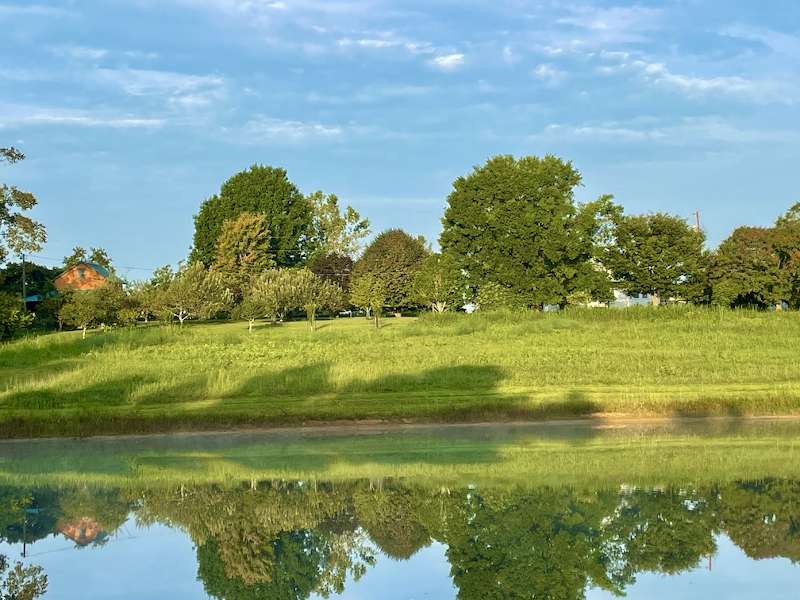
The Blue Door of a Dream: My Journey through Poetry
I grew up in the shadow of elms in rural western Connecticut and spent my childhood roaming woods and meadows, with jack-in-the-pulpit and the scent of sweet fern for companions. Unchurched, I absorbed through my pores my mother’s belief that every leaf and stone is holy.
the unblinking eye
of a painted turtle
laying eggs . . .
how long does it take
to birth a universe
~from ‘In a Grain of Sand,’ a tanka sequence
red lights 17:1, January 2021
And from earliest childhood I was immersed in the sounds of poetry:
my mother’s voice
reciting The Highwayman
by moonlight
the gleam of a dark red love-knot,
the clatter of galloping years
~Moonlight on Water, 2016
For four years, I attended the last operating one-room schoolhouse in New England, but I composed my first poem before I learned how to write. I still have it somewhere, penciled on brown paper in my brother’s hand.
at age five
my first poem, an ode
to lampshades—
trying ever since to grasp
the nuances of light
~A Hundred Gourds 3:2, March 2014
I continued attempting to write poetry throughout high school and college, but while I was busy earning two degrees in biology, pursuing two careers, and raising two children, my muse was often sadly neglected.
scribbling
poems to eat
on the grocery list
I let the toast
go up in smoke
~Atlas Poetica 13, Fall 2012
During my first career, I wrote and edited educational materials about biology and science. Motivated by my younger son’s disabilities, I embarked on a second career teaching children (many of them nonverbal) how to communicate by any means possible. So the threads were there—communication and the natural world—but they weren’t woven together into poetry for many years.
As a young adult, my disabled son moved to a group home, and some years later I retired. With time to think at last, I began writing more than I had in decades. I published a fistful of poems and won a couple of awards from my state poetry society. I wrote mostly free verse but experimented with various forms, including a few haiku.
Then I stumbled upon tanka in Jane Reichhold’s little book, Writing and Enjoying Haiku: A Hands-on Guide. The genre immediately appealed to me. My first published tanka comprised an entire sequence, ‘The Rosewood Bird,’ which, to my amazement, was one of three winning sequences in the twentieth Tanka Splendor Contest sponsored by AHA Books. Writing that sequence about my father showed me the uncanny power of tanka to explore even a complex grief muffled for forty years.
still folded
in a trunk
the sweater I wore
the day I learned
what you had done
~from ‘The Rosewood Bird,’ a tanka sequence,
Twenty Years Tanka Splendor, AHA Books, 2009
Soon I was writing tanka pretty much exclusively. In 2012, I joined Jane Reichhold’s AHA Poetry Forum, which was immensely helpful in developing my skills. My engagement with tanka grew steadily, and within a few years I became Moderator of AHA’s Tanka Forum, and also Reviews & Features Editor of Skylark Tanka Journal, a position I filled for over five years.
In 2016, I co-edited the Tanka Society of America Members’ Anthology, Ripples in the Sand. After the untimely death of Jane Reichhold in August of that year, and the subsequent demise of the AHA Poetry Forum, I was involved in the creation of Inkstone Poetry Forum. Also that same year, Skylark published my first tanka collection, Moonlight on Water.
the story
of my life as a changeling—
this poem
a silk purse stitched
from a sow’s left ear
~from “a sow’s ear,” a tanka sequence
kernels 1:1, April 2013
During these years, I wrote mostly individual tanka and tanka sequences, although I also published quite a few tanka-prose pieces along the way. I used tanka as a medium to explore everything: my personal and family history, my relationship to the natural world, my wonder at the cosmos. Although I do occasionally write haiku, I find that tanka’s five lines afford the writer just enough space to explore the subterranean passageways that connect subjective and objective realms, psyche and Gaia.
stumbling
into a world new-made
I search
for the shape of my face
in a pool of dreams
~from ‘Lost,’ a tanka sequence
Only the Dance, 2021
In recent years I have increasingly focused on using tanka to celebrate and mourn the natural world, as human actions seem hell-bent on destroying what created and sustains us. In 2021 I published my second book, a small collection of tanka sequences on these themes, called Only the Dance.
Currently I am writing more and more tanka-prose and occasionally haibun, exploring what it means to live in this Anthropocene Epoch, with its runaway global warming and mass extinctions. Writing prose gives me space to tell the stories of what’s being lost, and interweaving poems into the prose allows me to reflect on those losses. Nature, of course, will outlive the destructive human species, but so much will surely be swept away before we’re done. My task is to bear witness.
a rift in the wing
of a wild goose
flying headlong
through gathering dusk
the fate of the earth
~from ‘Beyond the Threshold,’ a tanka sequence
red lights 16:1, January 2020
closing behind me
the blue door of a dream
I hear the words
don’t forget the absolute
yet love the leaves & branches
~ from ‘Credo,’ a tanka sequence
red lights 13:1, January 2017
my breath is the wind
that carries a leaf with rain in its veins down to the earth that built my bones from fire and clay
floating
behind my eyelids
the cosmos
~Under the Bashō Nov. 15, 2020
LINKS
Books:
Blog:
Publications on Drifting-Sands-Haibun:
Selected Tanka-Prose & Haibun Elsewhere on the Web:
![]()
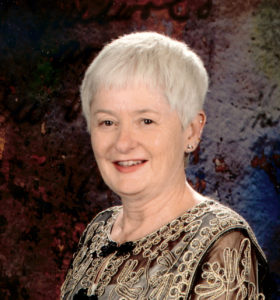
I was born and raised in Calgary, Alberta and still make my home here. I would like to take this opportunity to acknowledge the traditional territories of the people of the Treaty 7 region in southern Alberta. The City of Calgary is also home to Metis Nation of Alberta, Region 3.
My husband and I were married in 1977 and together we’ve travelled to 36 countries on six continents. We agree with St. Augustine who famously said that the world is a book and those who do not travel read only one page. We’re closing in on a novel!
My haiku journey began long ago in high school, when I started reading Basho’s poetry and was intrigued by haiku’s ability to say a lot in just a few words. Later on I joined Haiku Canada and presently I’m a regional coordinator for Alberta, Saskatchewan and Manitoba. I also write poetry book reviews for Haiku Canada Review. I’m a member of Tanka Canada and I write book reviews for that organization’s journal GUSTS: contemporary tanka. As well, I sit on that journal’s tanka selection committee. Here are some poems that have appeared in those journals.
storm clouds
the marching band
picks up speed
connected to peace Haiku Canada Members’ Anthology 2023 and TINYWORDS, 22.2, 20 Oct. 2022
melting snow
I recycle
sympathy cards
Haiku Canada Review Vol 17, Feb. 2023, No. 1
traffic jam
a bumper sticker
amuses me
honk if you love
peace and quiet
GUSTS contemporary tanka No. 37, spring/summer 2023
rainy day
the cats and I
curl up for a nap
my best laid plans
are laid to rest
GUSTS contemporary tanka, No. 37, spring/summer 2023
Here’s one of my haibun that appears in contemporary haibun online.
Silver Threads Among the Gold
After an afternoon of shopping I notice a seniors discount on one of my receipts. Seniors’ discount? What’s next – someone offering to help me cross the street? I crumple the receipt in my pale, blue-veined hand. Then I smile.
falling leaves
the box of hair dye
unopened
cho 19.1
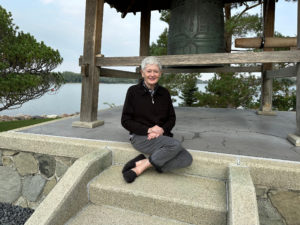
As you can see, I sometimes add a touch of humor to my poetry, which is in keeping with my designation as a Certified Laughter Leader with The World Laughter Tour, based in Columbus, Ohio. I use the techniques of laughter therapy to enhance certain aspects of my social work practice. Laughter is the best medicine! In that regard, for the second consecutive year ( 2022, 2023), I’ve won a Dishonorable Mention in the Bulwer-Lytton Fiction Contest, which challenges participants to write the worst opening line in a fake bad novel. They’re fun sentences to write – and read!
I’ve published five collections of my poetry, one of which is a scifaiku collection. Yes, I have a dark side, as illustrated in these scifaiku from the collection titled A Nameless Place, published by Sam’s Dot Publishing.
in space
there’s no morning
no mourning
alien funeral
mourners shed their skin
instead of tears
These were inspired by own off-kilter imagination, as far as I know!
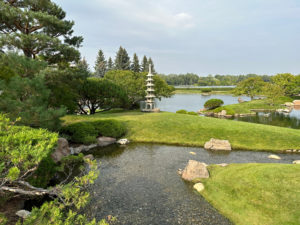
I’m also inspired by peaceful places like The Nikka Yuko Japanese Garden in Lethbridge, Alberta, where I wrote this haiku.
Japanese garden
not one flower
to spoil the view
~
~
Website: www.joannemorcom.ca
X (formerly Twitter) @joannemorcom.ca
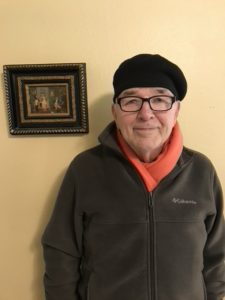
I am a retired psychiatric nurse living on a nature habitat near Newberg, Oregon. On my seventeenth birthday, I dropped out of school and joined the U.S. Army. I was stationed in Germany after training as a combat medic and paratrooper. After my discharge, I spent time aimlessly hitchhiking around the country with no special place to go. Later, I hitchhiked throughout Europe, across Africa, the middle east to India and Nepal. Eventually I became a merchant marine, making my home in Paris and the south of France when not at sea.
In 1969, I returned to the U.S., transporting military supplies and troops from San Francisco to Okinawa, Korea, and Japan. On one of my trips, I visited the famous garden of Ryoan-ji in Kyoto. That sparked a lifelong interest in Zen. I gave up sailing to become a student, majoring in Asian studies at San Francisco State where I discovered haiku and R.H. Blythe. There was a vibrant poetry and Zen scene at the time, and I was fortunate to be a work study student at the Poetry Center, epicenter of the San Francisco poetry scene. Through my work, I met most of the major American poets of that era. Meeting the poets and hearing them read their work gave me an interest in writing and poetry. At the same time, I was attending classes at Zen Center and taking classes in Buddhism at Berkely. I was fortunate to have met dynamic teachers like Paul Reps, Philip Whalen, and Alan Watts who were interested in the correlation between haiku and Zen. My wife and I moved to El Paso, after a couple years in Ohio.
I finished nursing school and obtained a graduate degree at the University of Texas in psychology. During this period, I started publishing short articles and stories for various magazines as a hobby. In 1988, We moved to Oregon and my interest in haiku spiked. I took classes in Japanese tea ceremony and became marginally involved with haiku enthusiasts in the Pacific Northwest. The area attracted serious haiku poets, people like Francine Porad, Michael Dylan Welch, Ce Rosenow, Sam Hamill, and Maggie Chula. I became friends with Lorraine Harr, pioneer editor of Dragonfly, one of the earlier haiku journals. She encouraged me to write little articles and haiku for small journals. I don’t remember all I published and many of those journals, Woodnotes, Northwest Literary Review, Sudden Showers, South by Southwest, Cherry Blossom Rain, others, no longer exist.
After a couple years, I started to lose interest and became disengaged from the scene. Five years ago, about 2020, I discovered Portland still had a haiku group, (Haiku Society of America). This talented, diverse group encouraged me to write haiku again. Also, about this time, I got hooked on flash fiction after taking a class with Anna Keesey. The new flexibility and possibilities combined with short prose stimulated me to write again. I don’t take my writing seriously; I think of it as a hobby. And I am constantly grateful to the staffs and editors of journals and websites such as Drifting Sands for keeping haiku alive and for providing a source of publishing. Recently, I assembled fifty of my currently published haibuns into book form. It is titled, Just Enough Moon, and is available from Amazon. I am always interested in contacts or information exchange with others who are interested in Japanese inspired haiku, haibun, and tanka. I may be contacted at
![]()

Neena is a banker turned poet from Chandigarh, India. She runs a non-profit for the education of underprivileged children.
Her haikai poetry has featured in online journals and magazines viz. Presence, Frogpond, The Heron’s Nest, Contemporary Haibun Online, Asahi, Under the Basho, Prune Juice, Chrysanthemum, The Haiku Foundation, Wales Haiku Journal, Acorn, Cold Moon, Failed Haiku, Haikuniverse, Heliosparrow, PoetryPea, and others.
She has self-published two books of poetry—“Whispers of the Soul-The Journey Within” and “One Breath Poetry”
My journey as a haiku poet
Haiku writing was a mystery to me when I published my first poetry book “Whispers of the Soul”. Though I did write 3 lined verses, the intricacies of haiku, senryu and tanka were unknown to me. Then, through divine serendipity, Dr Angelee Deodhar, a celebrated haiku poet came into my life. She became my mentor, friend and haiku guru, as I used to call her to her wry amusement.
She instilled in me a deep fascination for this art and its connect with Nature, and life became imbued with its beauty.
Nature being an abiding love – long walks in gardens, conversing with trees, birds and squirrels, moon-gazing, journeys to far-away lands, the vignettes of daily life, all spoke to me, and I started sharing haiku with Angelee, my family, friends and online journals.
Studying the works of old haiku masters, contemporary poets as also online mentoring by The Haiku Foundation helped me understand the nuances of haiku and other genres of Japanese poetry.
A visit to Japan (the birthplace of haiku, senryu & tanka) and initiation in Soka Gakkai Buddhism based on the teachings of the Japanese monk Nichiren, further motivated me to write and share my experiences through haiku. The minimalistic style of writing poetry triggered my creativity. Writing haiku, capturing a moment in time, helped me become more present and aware of my breath.
The 17th-century Japanese haiku master Basho said, to write haiku, get a three-foot child. Yet, to write haiku well is an ongoing journey…requiring study, practice and more practice. The journey continues with the guidance of many mentors to whom I remain eternally grateful.
Read my published poems on my blog: Whispers of the Soul
![]()
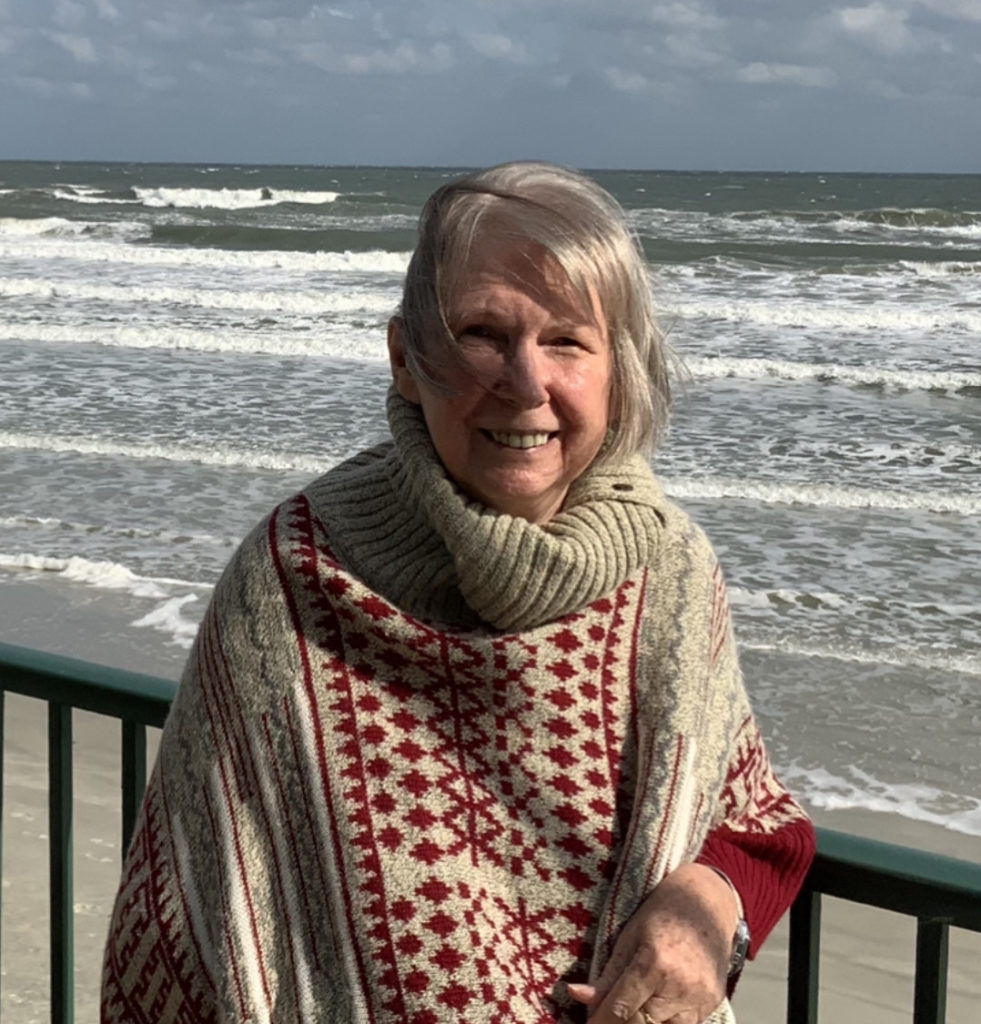
A former Clinical Psychologist, sailor and bicyclist , I make my home with my husband in the Greater West Palm Beach, Florida.
we skinny dip
in the community pool
full moon
Frogpond, 2009
I started writing both free verse and short forms in 1999. I had always wanted to write novels but was hit with a neuroimmune illness in 1990, causing fatigue, dizziness, inability to tolerate light and sound. It took nine years for a doctor to find a med with anti-seizure/neuro calming properties that helped me regain my ability to use the computer and become clearheaded enough to write again. Anything long was too challenging, so I started dabbling with very bad haiku and was gradually able to write more and better over time as long as I paced my energy. Many writers taught me and encouraged me along the way, as did reading good work. I especially love writing tanka, tanka prose, haibun, and creating haiga. In my earlier years I wrote more free verse.
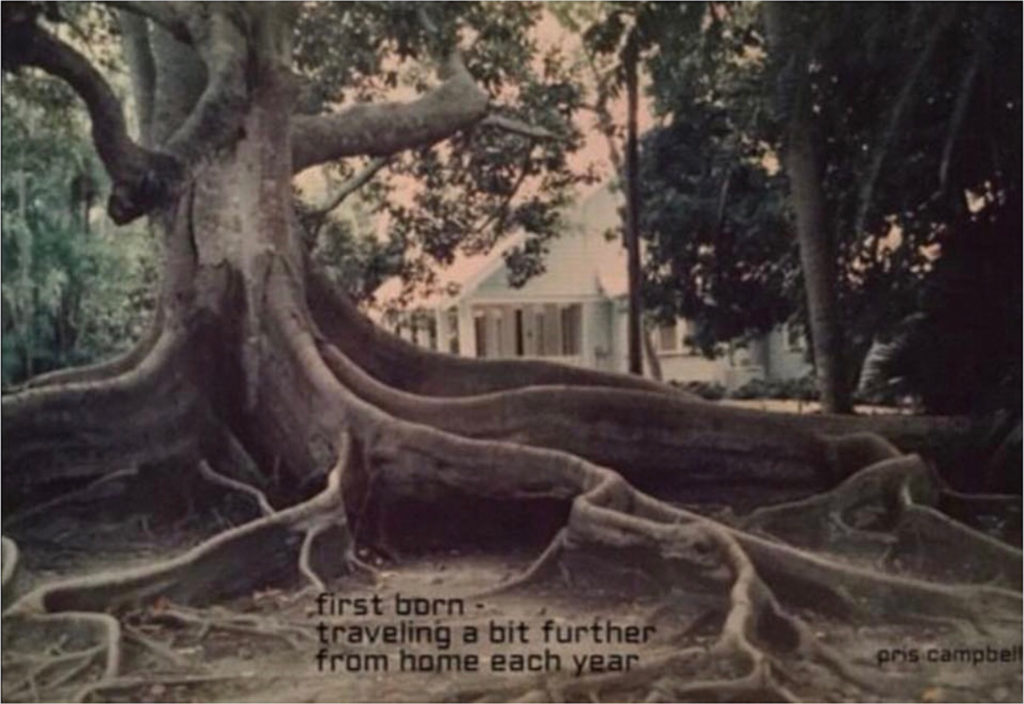
As a result, my free verse and short forms have appeared in numerous journals and anthologies such as Eucalypt, GUSTS, PoetsArtists, Nixes Mate, Mayfly, Rusty Truck, Drifting Sands, Presence, Frogpond, Acorn, and Outlaw Poetry. Nominated seven times for a Pushcart, the Small Press has published seven collections of my free verse poetry and one book of tanka. My Southern Childhood, from Nixes Mate Press is my most recent book. In 2021 I was thrilled to take first place in the Marlene Mountain monoku contest and the Sanford Goldstein tanka competition.
Below are some samples of my work . . .
the constancy of change
autumn, and the florida heat still has its way with us. soon the snowbirds will be creeping in to hide from the northern cold. already, a giant blue heron has checked out the pond behind our house where baby moorhens have been growing, preparing to leave for a new spot in these southern climes.
goodbyes come in heavy doses. I think of friends dead just since january, one friend lost so suddenly to dementia, the stories I still want to share with them. to console myself I think of my father’s old garden, silver queen corn in his arms, rushing inside to toss the husked cobs into boiling water before sugar turned to starch.
I’m grateful I also gathered the many sweetnesses passing through my life in time.
nightfall
a newborn’s cry drifts
through my window
Failed Haiku, November 2021
my old home sits
next to unturned soil
string beans
and silver queen corn
long for my father’s hand
First place—2021 Sanford Goldstein Contest
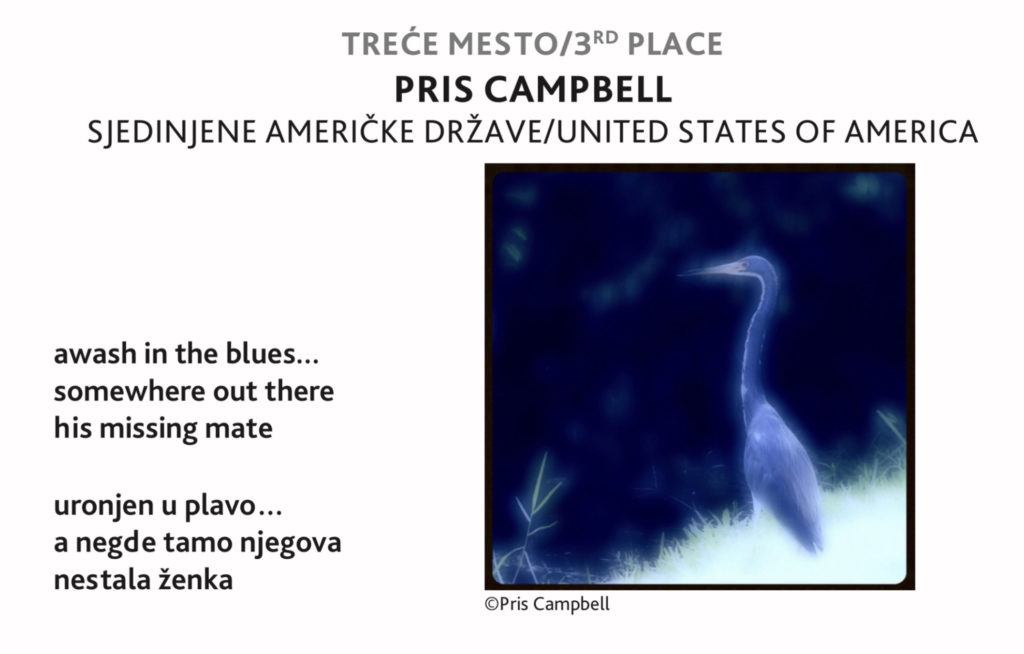
Damaged
Broken diamonds fill the sky. Wild horses thunder past on the beach. Surf drenches my calves. I want him back but the gulls cry no, no as they flap across the fading horizon. His loss washes over me until I want to give up, be carried helplessly out to sea with the mermaids. I collapse into the tidal pools until the sky turns pink again. Dying starfish wash up to shore. His ash settles over me, warming me.
autumn winds
the empty nest
blows away
Frogpond, 2021
Some links . . .
A haibun broadsheet created by Nixes Mate Press
https://outlawpoetry.com/2019/resourceful-by-pris-campbell/
One of my free verse poems
https://rustytruck.wordpress.com/2017/05/09/for-a-moment-by-pris-campbell/
In Drifting Sands . . .
https://drifting-sands-haibun.org/04/2020/other-voices/
https://drifting-sands-haibun.org/05/2021/dark-side-of-the-moon/
https://drifting-sands-haibun.org/10/2020/ms-lonely-hearts/
My website: poeticinspire.com
Twitter: @priswriter
Facebook: Pris Campbell
![]()
Presently I serve as a consulting editor for Drifting Sands Haibun and as Encore Editor for Contemporary Haibun Online. My partner Nancy and I live on a rural acreage in Halton Hills, Ontario, Canada. Both retired, we enjoy hiking in the Rocky Mountains and Utah’s Canyonlands, walking in the nearby mixed-hardwood forests, bicycling our hilly, twisting rural roads, canoeing Ontario’s Muskoka lake country, and most of all, we love avoiding Toronto and the infamous hwy 401. Nancy is a fibre arts crafts person and I’m a writer. We both enjoy photography. I have a recurring dream that in a previous life I’m a university professor teaching social sciences.
My Journey on Basho’s Pond
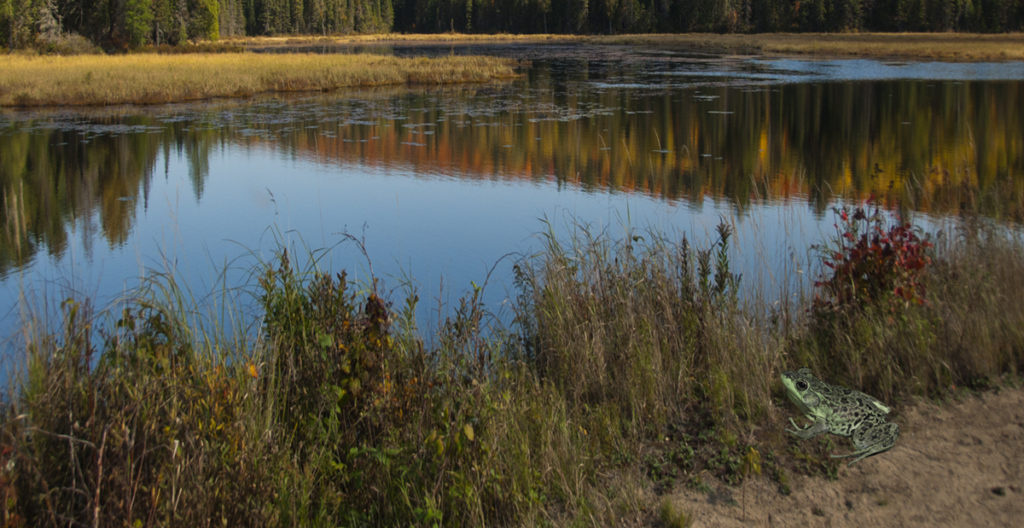
It was about 20 years ago, after an enchanting photography visit to the Kurimoto Japanese Garden that my writing journey started. I decided to do a photography website showcasing the Garden and wanted include Asian poetry, which I didn’t know much about, to complement the images. On a search, I discovered haiku which, like photography, is about simplification and involves expressing the heart of visual experiences.
Next I decided to try writing stand alone haiku and haiku for my images (haiga) – after all, who doesn’t want to be a poet? I thought it would be easy to create 17 syllables in 3 lines. After showing my first 3-liners on haiku forums, I was quickly disabused of the notion that composing haiku is simple. One well-published haijin (haiku poet) said that my haiku was “an aphorism, and not a very good one at that.” Ouch, that hurt!
In time, with a lot of reading and practice and coaching, I was able to succeed in having a few haiku and haiga published, and success inspired me to do something I’d always wanted to do – write about personal experiences to share with friends and family. I read read other genres in the journals, found my way to haibun pieces and thought, this is more what I want to do – tell stories about real personal experiences and add haiku. For some reason, I didn’t just want to write personal essays or memoir snippets. I liked the idea of finishing with a haiku.
While initially I aimed my writing at family and friends, over time I wanted some sense of validation that my writing was okay. I knew I couldn’t get that from family and friends – they’re thoughtfully diplomatic. So I began to submit my work to editors, themselves established writers, to learn whether they thought my work was good enough to publish and show to their readers. I was happy to get my work into any journal, but over time I want my work to be placed in journals that are difficult to get into. At the start, similar to my initial attempts at haiku, the reactions I got went like this: “Interesting story but you need to understand and be able to write haiku-like prose.” Ouch, that hurt again!
And again, in time, I succeeded in having my haibun published. At this point, I’ve had more than 200 accepted in a variety of journals which importantly are edited by different editors with a variety of tastes. Why important? I believe that most editors have a mission to please their readership and thus they try to select the best of the submissions. And I’ve learned that each editor has his or her own tastes about haiku, haibun prose, and the marriage of the prose and haiku.
Even with success, haiku, the necessary little partner of haibun’s prose, remains to this day my Achilles heel. And why shouldn’t it be? As one famous haiku poet put it, “I hope to write a few good haiku in my lifetime.”
Community Service
While learning my trade in haibun, haiku and haiga and finding my own expressive style, or what some call “voice,” I was appreciative of the work that volunteer editors put into reading and accepting (or not), and making suggestions for submissions to their journals. I received great help from several editors. So I decided to give back to the haiku genre community. Early on, I designed the Simply Haiku website. Under the editor’s leadership, it evolved into a very good multi-haiku genre journal. Then I designed (or helped with the design) of other journals foused on haibun including Contemporary Haibun Online, Haibun Today, A Hundred Gourds and Cattails.
At some point, I was asked to serve as an haibun editor and I edited for the World Haiku Review, A Hundred Gourds, Simply Haiku. For a long period, I served as a haibun editor and then as Editor-in-Chief of Haibun Today.
As I write this I’ve stepped down from 10+ years of editing, and now I help out with technical issues and advice to various journals. Right now, I’m helping format Drifting Sands Haibun and training volunteers how to format the journal. I’m Also presently the Editor of the Encore Section of Contemporary Haibun Online where I select “classic articles” which have been all but lost and should be read by new writers and those wishing to improve their understanding of haibun.
A Favourite Published Haibun
The Bathrobe
One rack in the men’s shop contains richly colored robes with fancy lapels, threads a James Bond might wear while romancing one of his many women. I reach for bold red and gold plaid with shiny black lapels.
Suddenly awake, anxious, I glance at the hook on which my robe hangs. Relief! Still there.
There are large patches where I’ve had my seamstress salvage it after large holes grew in the wrong places.
“Robes aren’t that expensive. Why not just buy a new one?” my seamstress, a very practical woman, had suggested.
“No,” I said, “I like this robe.”
“Do you want exactly the same kind and color of cloth?”
“It’s just a robe. Do your best.”
Having had it patched didn’t relieve my fears. When my wife looks at it, I see the rag basket in her eyes. When it falls to the floor, the dog happily sleeps on it.
Men reading this know that the robe and I won’t soon be parted. No one else sees it and only my wife is concerned about a little flesh hanging out here and there.
I pull the comforter over my head and drift back to sleep.
lucky moon –
even when waning
no one threatens to replace you
. . .
Note: haibun published in Haibun Today & the Contemporary Haibun Anthology.
A Favourite Haiga
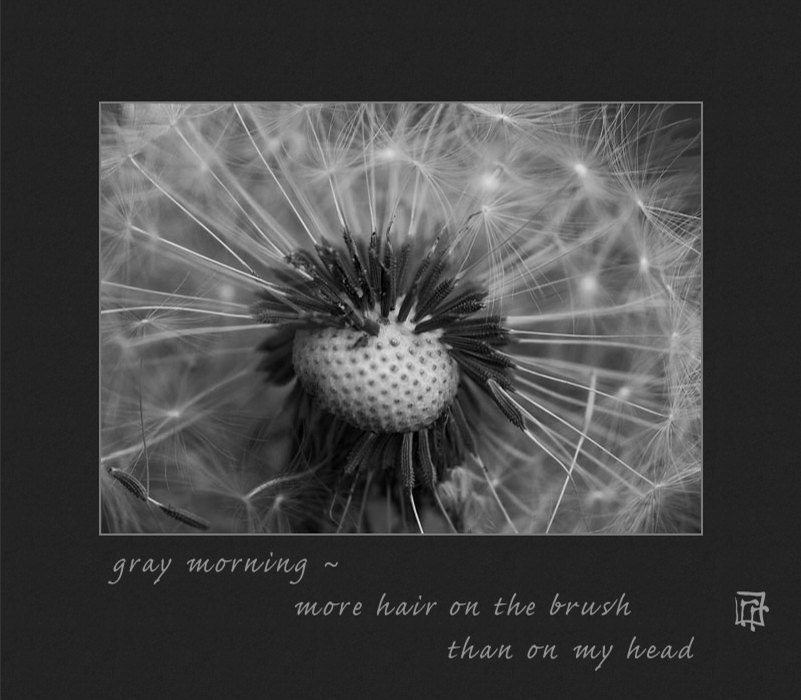
Websites, Blogs and Books
- Haibun & Haiku Blog
- Day’s End: A Multi-contributor Haiga Website about Aging
- Romance Under a Waning Moon: Multi-contributor Late-in-Life Haiga
- Wabi Sabi Website
- Haiku, Haibun and Haiga information website
- Landmarks: A Haibun Collection
- Photography website
Publications in Drifting Sands Haibun
Essays in DSH and Elsewhere
- What Are We Writers Up To, Really! (DSH)
- The Writer’s Gaze (Contemporary Haibun Online)
- Commentary on Basho’s “Hiraizumi” (Haibun Today)
- Characteristics of Contemporary English-language Haibun (Haibun Today & CHO)
- A Title is a Title is a Title, or Is It? Titles in Haibun (Modern Haiku, Haibun Today)
~ End ~
![]()
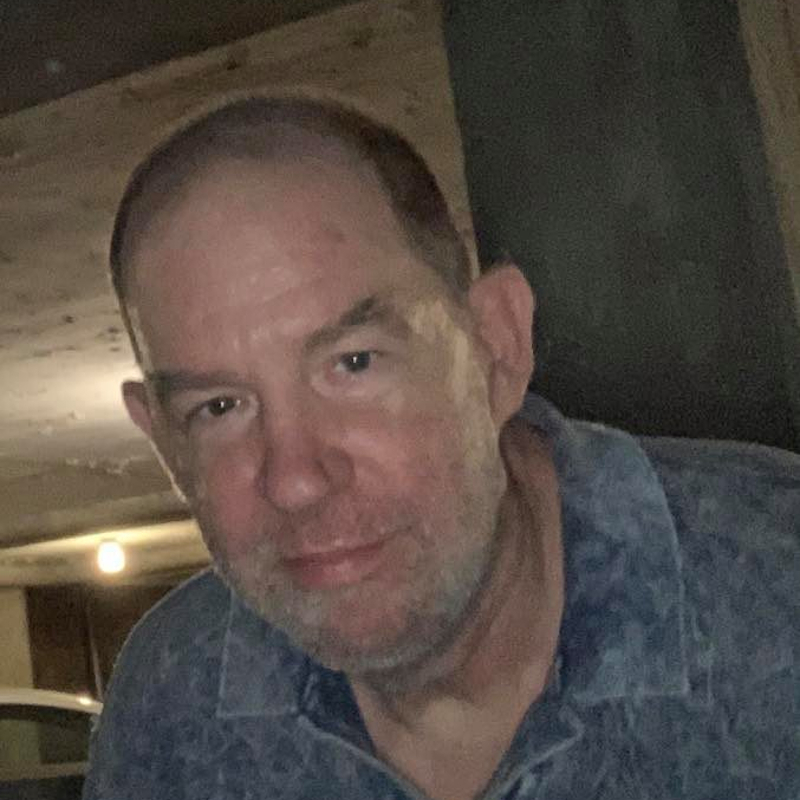
Evanston, Illinois USA
I am a mixed-genre artist currently living in the city of Evanston, Illinois, the founder and developer of drifting-sands-haibun.org, and an active haibun, tanka prose, haiku/senryu, tanka, and haiga poet. I grew up surrounded by the woods and fields, lakes, and streams of Wisconsin and Maine. In the city, I enjoy every experience with nature I can get. I also enjoy sculpture, photography, music, and community web development. I don’t own a television and would like to keep it that way.
Enchanted
The poet eases into his favorite chair, fingers waiting eagerly for a puff of imagination to settle onto the keys. One by one, each digit moves, and slowly a dance ensues.
He searches for his partner. The muse alights in his mind. They step out onto the page and begin to twirl.
one
the storybook begins
with “once upon a time”
from there we’re left to find a way
to weave our dreams
between the lines
two
many yesterdays ago
there lived a pair on a hill
he walked each day to the spring
to fetch her a cup
of water
three
milady, your hands
fit into mine
as stars fit into the sky . . .
if this is all a dream
then please try not to wake me
one . . .
My Journey as a Writer
I began writing poetry and prose in college. Not much—just enough to whet my appetite. I was pretty good at writing term papers and wound up helping several classmates with theirs. My first paper was a ten-page essay on the birth of jazz. My English teacher, Dr. Rittner, met with me after class almost every day to provide hints and tips. One of his mantras was a prescription for, “daily doses of dictionary.” He taught me many things that were and are instrumental in my pursuits as a writer.
hand-me-down shirt
with a pen in the pocket . . .
inky sunrise
For many years, I just wrote conventional poetry. Then, about five years ago, I became extremely ill and spent a lot of time in the hospital and then a nursing home. For the previous 15 years, I was completely absorbed by website design and had little time for writing, music, or art. The illness changed all that.
Joyce, a counselor at the nursing home, called me to her office one Friday. She said, “You seem bored. I have something for you,” and handed me a 30-page notebook and a pen and said, “Here, go do something creative with this.” I think she thought I would draw. Instead, that night, I sat down to write her a thank you note on the first page. After a few words, I realized I was writing a poem. So, I finished it. Then, over the course of the weekend, I filled that notebook with poems. After two more weekends, I had a collection of over 90 poems. Almost all were written about those I’ve crossed paths with throughout my life; the first poem was for Joyce.
I open the door
and a tabby slinks in . . .
warm milk by the fire
Eventually, I developed a desire to see this hand-written poetry typed up and printed out. A CNA at the nursing home told me she would help type them up. That was a great idea but it didn’t work out. Instead, she was sitting in the dayroom typing on a tiny, purple, keyboard-equipped, tablet computer one day when I mentioned, “that’s pretty cool.” She told me she hardly ever used it. I asked her if I could borrow it sometime. She said, “No, you can have it.” Wow, Shara! How you unchained my mind that day.
a breeze in the meadow
the stormy sky
fading
I began my first-ever attempt at compiling my poetry that weekend on my newly acquired purple gizmo, then set out to build a free website to post it on. Concurrently, I started writing new poems on the tablet, and began a memoir, no thoughts of publication on either front at that time.
During my stay in the nursing home, I came upon a Facebook group titled, Virtual Haiku, managed by Michael Rehling. There I started to learn about haiku and was later introduced to haibun.
I wrote and submitted my first haibun in the spring of 2018. Bob Lucky at Contemporary Haibun Online wrote me back with a couple of suggestions. One, that haibun most often have a title, and two, that he felt I could drop the second haiku. I followed his advice and he accepted the piece. I look back and realize just how—???—that haiku was and still is. The first haiku in the haibun, though, seems stronger now than it did when I wrote it. It has many facets I’m only starting to see as my exploration of the haiku/tanka genres continues. It was just the emotional relief I needed; a huge adrenalin rush. I don’t need that rush anymore to enjoy writing haiku and haibun, tanka, and tanka prose. It’s been less than four years since I first laid eyes on these forms but I’m addicted. There have been many publications since the first, but the first one was special. Thank you, Bob, for the long-lasting rush.
learning to tie my shoes—
the school bus is late
so I’m right on time
Illness brought me back to poetry, art, and music. I’ve recovered and now spend my days writing, sculpting, taking photos, and working on Drifting Sands, which is my way of saying thank you to the haibun community that I credit with saving my life, literally.
Here’s a compilation of my short-form poetry (much of it was written during my stay in the nursing home). There’s plenty there already but still, a lot of data entry to do:
Community Web Development
I began my web development carrier in 1998 by asking myself, “how do I create a blank web page?” I found a website with some basic HTML examples and built my first webpage (hosted on my own computer). It had a title and some text. I’ve spent the last two decades educating myself in this medium. Along the way, I learned database development and several computer programming languages. I have been an independent developer for about the last 20 years.
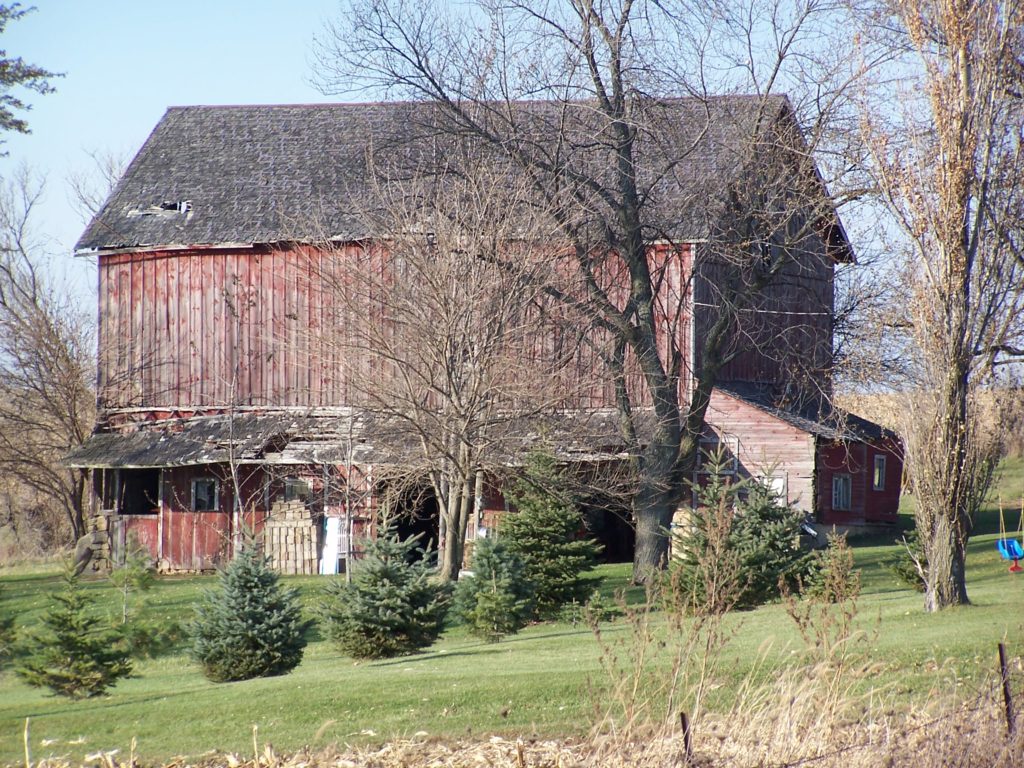
I moved to a rural county in Wisconsin in 2004. The county’s websites were either in shambles or non-existent. That included the nine Chambers of Commerce websites, the tourism website, and the county’s business development website. Businesses and organizations in the county were underrepresented on the Web—most didn’t have a website. So, I went to work creating an information hub from scratch. The result was GreenCountySpotlight.com (now defunct).
Green County Spotlight was first and foremost a directory. It contained pages for virtually every business, organization, and tourist attraction in the county. The site had a complete, hand-built content management system (CMS) much like what Facebook offers today but Facebook still hasn’t caught up with what we created back then.
the village gathers
for a helping
of stone soup . . .
a stranger with a ladle
stirs the pot
Each directory listing on the site was completely customizable (images, text, links, and other media such as videos). First, we went through the phone book and entered each entity by hand (name and phone number). Once that was complete, we began to reach out to the various entities for more information, offering to create their custom pages for free if they weren’t able to do it themselves. What we compiled was a network of beautiful pages that showcased the county. Eventually, we were working with Chamber directors, state Congress-persons, city officials, schools, libraries, museums, the tourism department, and the business development corporation. The site had classifieds, an event calendar, news, maps, and the weather report.
The point being, we spent eight years working with local communities with widespread success. Then I moved away, went through a mess of gyrations, after which I came through and up with my next community project, Drifting Sands Haibun. Drifting Sands is a constantly evolving project (the Poet’s Hub is just one example of that). We’re staffed entirely by volunteers and the project which was originally paid for out of my own pocket now has donors who help defray the costs. Everything we do at Drifting Sands is about fostering the community of writers and readers of haibun, tanka prose, and their related forms. The Drifting Sands Poet’s Hub is a direct descendent of Green County Spotlight only this time, it’s pages for poets. The experience of working with the communities in Wisconsin has translated perfectly to this project.
hoping for a quick reply
he sends his email
by carrier pigeon
Artist Endeavors
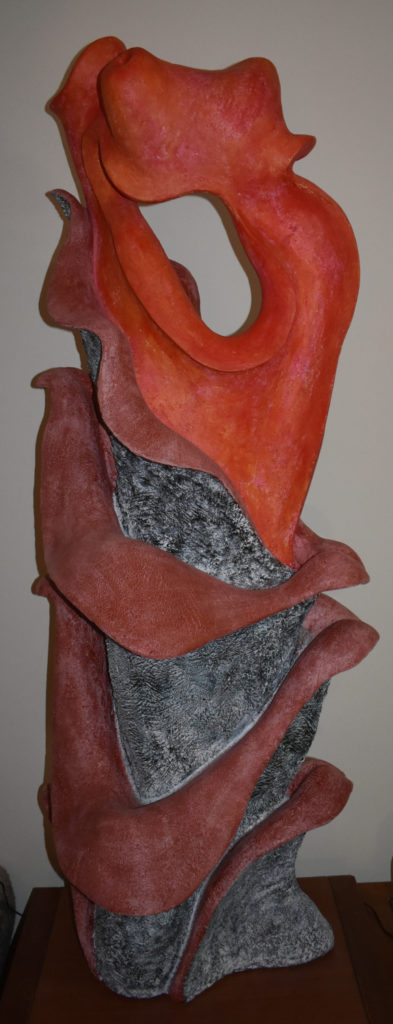
I first declared myself as a music major in college and stuck with that for the first two years. Then I took a sculpture class and things got crazy. Soon, I was spending all my time in the sculpture lab. During my stay at Chico State University, I created about 50 works of art in everything from paper to glass to wood to bronze, copper, aluminum, and steel. Just about everything I gave away. I have one piece from that era.
After school, I moved to San Francisco and landed a job as a metal finisher. My friend, Larry, referred me saying, “He can do it. He’s an artist.” The company I worked for made custom light fixtures, everything from chandeliers to floor lamps. Local interior designers would come in with their drawings and we would make them a reality. It was my job to put the final touches on. I worked with those designers to develop custom finishes, most of which made the fixtures look like they were a hundred years old. There, I made connections that eventually lead to commissions with local design firms, working for some of the wealthiest people in San Francisco. All the time, I was creating sculptures.
blackbirds flock
in afternoon sky…
flash mob
I eventually wound up working for the renowned interior designer, Robert Hutchinson (named by Architectural Digest as one of the top 100 designers of the 20th century). He would come down from his office to the studio with a drawing of a piece of furniture on a Post-it note and tell me, “Make this,” and then leave me to it. We worked on interior design projects together and I eventually started landing my own gigs.
Around Y2K, I was hired as a patina artist at an art-bronze foundry in the East Bay. Workers at the foundry were almost exclusively artists. Each was entitled to use the foundry for their own projects. I created three sculptures while I was there—five copies of each. I finished one of each sculpture and have those sitting in my living room. I finished two more and sold them. The rest are in my closet, in pieces, waiting to be finished.
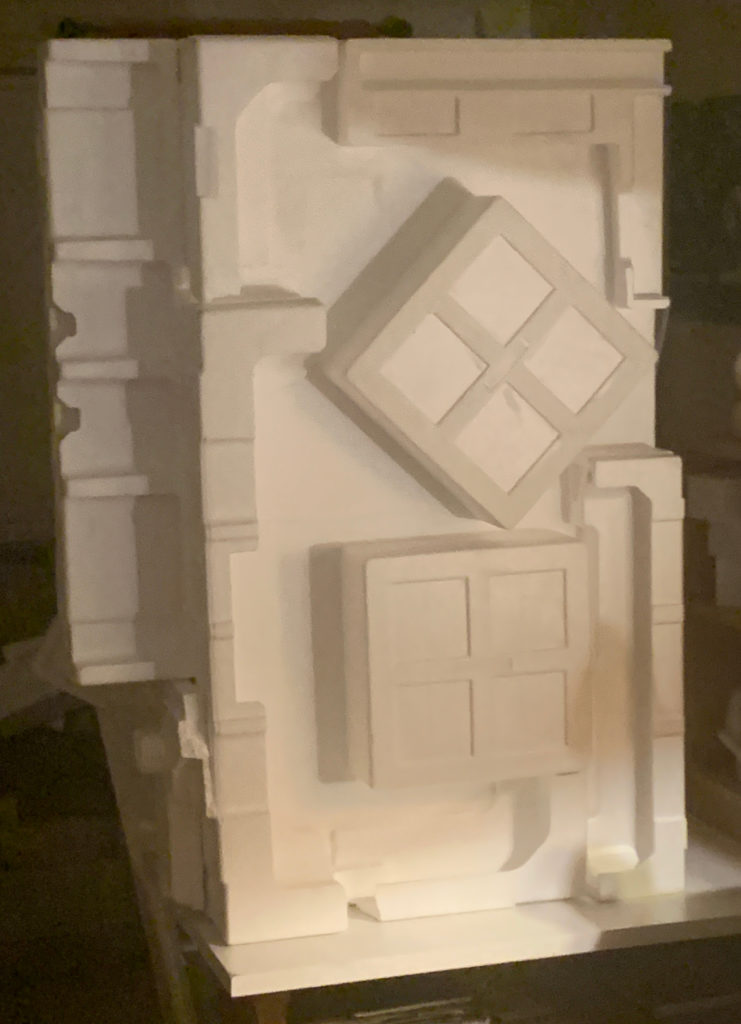
Now I work with discarded, reclaimed, repurposed Styrofoam. There’s one five-foot-tall sculpture taking up most of the dining room right now. All the pieces were rescued from a single dumpster.
he rattles the can
sniffs inside
the wind’s just right
this evening . . .
alleycat
I jump around from sculpture to writing to music on a daily basis. I find each of these to be meditative. Art and music influence my writing. Writing influences my art and music.
Photography and Haiga
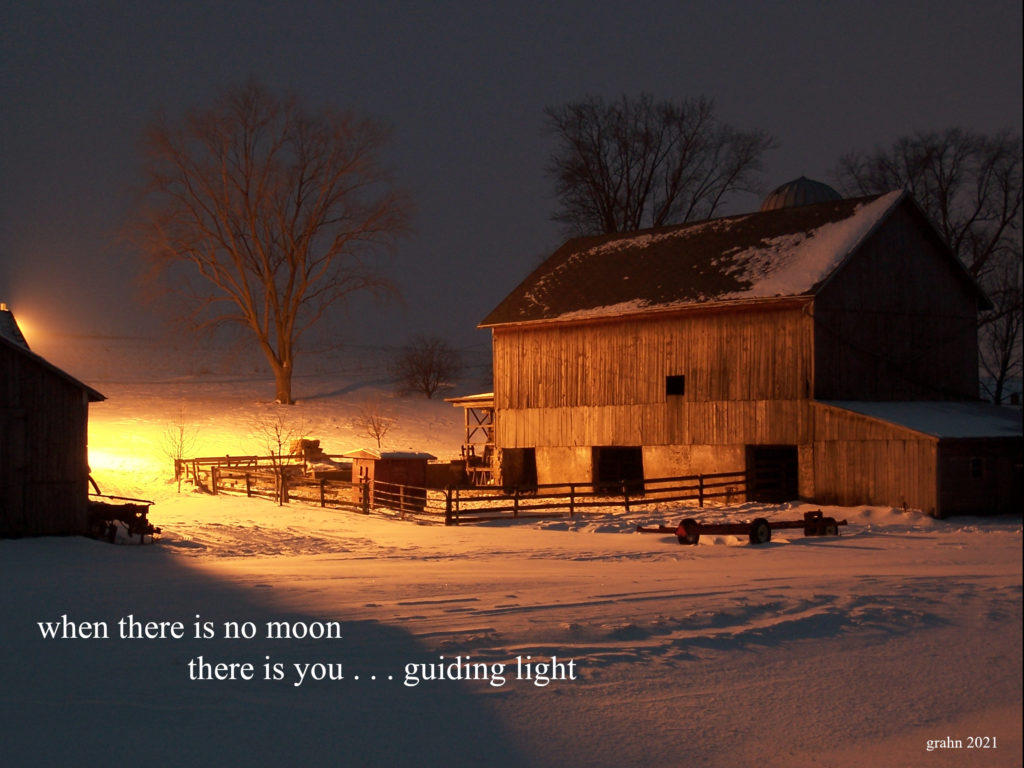
Dad gave me my first camera when I was 14. He had a darkroom in the house and taught me how to develop black and white film. I accidentally dropped that camera over a cliff three years later in Korea.
I experimented with film until I got my first digital camera around 2004. My girlfriend, Polly, and I took day trips with that camera all around Green County, documenting everything we could, from storefronts and churches to barns and alpacas. Anything of interest we could use for Green County Spotlight.
you can’t take it with you
but you can leave it behind . . .
a glimpse through the lens
and the world stands still
but am I really here?
I’m primarily a landscape photographer but there is little landscape in Evanston so I stick mainly to studies of flowers and trees. I have taken to employing photography and haiku or tanka to make haiga. The genre appeals to me on both the poetic and artistic levels—a natural marriage of interests. You can find more of my haiga in this Poet’s Hub blog post on my personal Drifting Sands – Poet’s Hub blog.
Music
I like most forms of music, from classical to jazz, rock, and blues. Most of the music I compose is on the experimental side. I enjoy improvisation in art in general, but in music, for certain. I love instrumental music. Nothing thrills me like a Frank Zappa guitar solo, or a Stravinsky orchestral piece.
hair tousled by the wind
filled with the urge
to sing like a bird
Took my first piano lesson around ten—”Chopsticks,” and “Mary Had a Little Lamb.” None of it stuck. The same thing happened with my college piano classes, but I did learn and hold on to some music theory. I’ve created about 15 albums in the last three years, some just one song (I say song but they are purely instrumental). Some of it “noise,” some of it mellow, some of it upbeat. Every piece has a different flavor. The fact is that it’s mostly improvisation. Here’s a recent album for your listening pleasure. Enjoy.
Meditation
ommmmmmmmmmmmm…
chanting to the echoes
of dewdrops in a teacup
lips invoke
the ancient songs
of life
where petals fall
into the pond—
a blossom
opens up and shares
its secrets
between what is
and the great beyond
an ocean
in a seashell
pounds the shore
one moment and no more
to spend inside eternity
to leave behind
what’s never been
and seek what’s meant to be
…shanti
Atlas Poetica #34, September 2018
![]()
← Back to my Drifting Sands Poet’s Hub Blog
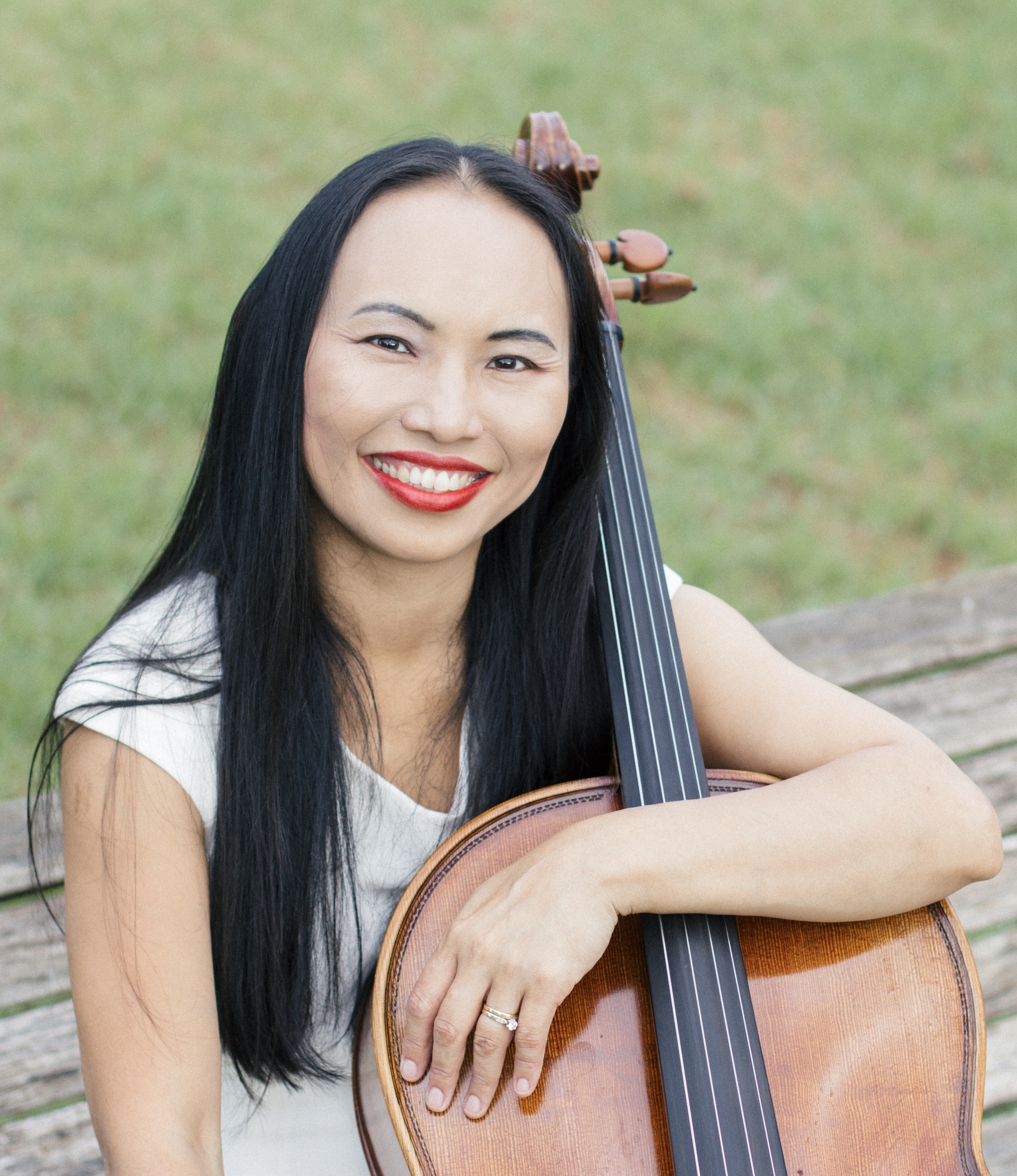
Sherry Grant is a Taiwan-born NZ concert pianist, cellist, poet and translator. She is the author of ‘Bat Girl’ and the inventor of ‘nonaku’ poetry form. Sherry organised and performed 12 concerts in 2019, mostly with viola. Her youngest daughter, 7-year-old Zoe Grant, writes with her frequently. Sherry is the national/international outreach officer at NZPS since 2021. Apart from music, she also has a bachelor’s degree in Computer Science.
Books:
– Bat Girl
– Speed Rengay (anthology)
– Rooster & Dragon
– Rengay Edge
Websites:
– www.batgirlbook.com
– www.artsinfinitypress.com
– www.nonaku.org
Facebook Groups:
– Chalk on the Walk Haiku
– Chalk on the Walk Monoku
– 2021 Hindemith & Copland Music Festival
I live in a faraway country called New Zealand, where more sheep than people reside. By profession, I am a performing classical pianist and cellist, collaborative pianist and my four children currently attend 4 different schools. In June 2020 (near the end of the first NZ Covid lockdown) I wrote my very first poem and haven’t stopped writing poetry since. 15 months on, I’ve written well over 2600 poems in both long and short forms, got around 300 poems published at over 40 journals or anthologies. My poem Combat Ready was shortlisted at the 2020 NZ Heritage Literary Awards and I published my first book of poetry Bat Girl with my youngest daughter Zoe Grant, who was 6 years old when we wrote the book together. Zoe is the co-author and illustrator of Bat Girl.
murmuration —
long forgotten
words return
I was born in Taiwan. When I was little, I’ve always loved world literature, poetry and philosophy. I was quiet yet curious. Having attended a special music academy since when I was 6 years old, I have remained in the exact same class with most of my classmates throughout primary and high schools (10 years). My friends nowadays could hardly imagine me as a shy person, but I spent most of my childhood in the company of books. In high school, I fell in love with the English language, and started devouring novels in English. At school I had the nickname of a walking dictionary when it came to English and my classmates would always come to ask me for help whenever they got stuck. I find English very intuitive, and feel thankful that I spent enough school years in Taiwan, which made it possible for me to translate my own poems into Chinese now, particularly my rengay. I have recently also started translating contemporary Taiwanese poetry as well as ancient Chinese poems into lyrical or haiku-like English poems.
the crows here
speak another tongue
feathery snow
After immigrating to New Zealand with my parents and sister, we started a new journey. We didn’t know anyone in this new home, but I was able to attend Auckland University, majoring in cello performance. The kiwi accent took a little getting used to, but after a while we found NZ to have a very welcoming mixed culture, although at the time of arrival most shops closed at 5pm sharp which was a big shock! We missed the busy lives, friends and food in Taiwan, yet we love the blue sky, green grass and way less population or pollution in New Zealand. Besides studying for my cello performance degree, I took language papers for fun and learned some German, French and Japanese. Now I am also learning Russian.
all the nights
merge into one
a silhouette
Every time I tried to go a different way, I got drawn back to music. I guess that is my calling and destiny. After studying post-graduate cello performance at Royal Northern College of Music in Manchester, UK on a scholarship, I thought it was time again to come off music and do something else. I took up computer science and did a degree at the Auckland University, during which time I also became the president of a computer programming club (SDK) and did all sorts of event organising including inviting experts working in the industry in for monthly seminars, and holiday computing programme for kids. I co-organised the first Auckland Linux Installfest with the Engineering Department at Auckland University and made the club a chapter of an international computing group (ACM). I think a bit of leadership skills showed through at the time.
statues
bow their heads
scurrying mice
After graduation from the computer science degree, I got married and had 4 children and that was the start of another adventure that put an end to my glamorous days. It was a period of lots of running around, with very little sleep or reading opportunities, or indeed any time for myself. So as soon as my youngest daughter Zoe turned 5 and started school in 2019, I organised 14 concerts in the “War and Peace” arts & music festival to celebrate the 100th year milestone since the year after WWI, as well as a memorial NZ concert tour “100 Years Journey”, in which I performed as collaborative pianist in 12 of the concerts. I was joined by marvellous musicians, particularly violists (Milan Milisavljević and Robert Ashworth) and commissioned 5 new viola pieces (music by Chris Artley, David Hamilton, Ben Fernandez, Carvin Knowles and Mathias Hutton) for premiere. I love the viola! We had a lot of fun onstage and I found this is what I truly love, to show my audience a glimpse of beauty from deep in my heart.
years later
these ripples
echo back
Then Covid hit. The arts and music industry took a major hit. We don’t know if we’ll ever safely return to the concert halls for performances again. Many of my planned concerts and festivals were either postponed indefinitely or cancelled. That was a dark time, but I think poetry gave me the light and helped me come out of it. All the lockdowns are hard on the children too, not having been able to go to school and meet their friends. I started writing poetry all of a sudden. One night at the start of June I got up to write what was to be my first poem after having gone to bed but not fallen asleep. I felt compelled to write it down and my poet friend told me it read really well. That gave me a bit of confidence. I didn’t think much of it, since I’ve never written poetry before. A few more days passed, then I felt inspired to write another five poems on the same day. That was when I decided this is fun, I should do more! And then I kept on writing poetry every since and never thought of stopping, even if people around me told me it’s not profitable and a bit useless — it made me feel better and later I found out my friends really love them too. That kept me going. My kids and I also started lockdown project Chalk on the Walk Haiku and Chalk on the Walk Monoku, to share haiku in our own way and introduce our haijin friends to one another.
slipping
into shadows
my soul
Poetry is such a divine way of expressing oneself, and I am a very fast writer. Whereas countless hours of music practice boils down to performances of an hour or two onstage, once a poem is written, it is to be read over and over again. My original goal was to reach 100 poems and gradually it grew into 500 poems, eventually I was able to write over 2000 poems in my first year. It is amazing where determination takes us. I have to juggle writing with housework so there are many poems written while cooking, doing laundry or dishes. Sometimes in the middle of driving I had to pull over to park and write down new lines of poetry. I have also written many rengay collaboratively with friends all over the world. We are gifted with a welcoming short form poetry community, to both new comers and seasoned poets. I am blessed with the support of my poet friends, the artist friends I continue to write poems for, and having composer friends who set my poems to music. I feel I have finally found my true calling, which is not only in music but in poetry. I wish to create the next Golden Age with my vision.
I scoop up
every birdsong
in mermaid tears
For more, please visit my Drifting Sands Poet’s Hub Blog.
Last update: 2021-10-23
![]()
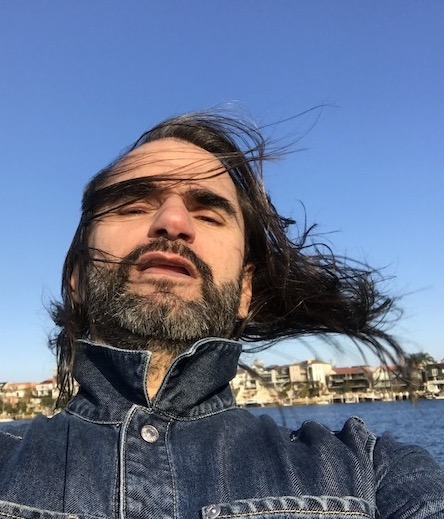
I was born, grew up, had a career and now… Hey! No! Wait! It’s not over yet!
I’m here. I’m alive. After struggling through a severe health-scare I thought there’s so much more to do than cocooning on the couch.
Writing fell into my lap; so to speak. About four years ago a friend suggested a creative writing course, to get out of the house, do something, meet new people. So I signed up and I haven’t looked back since.
Now I am a member of the Australian Haiku Society and have been published in various journals online and in print. I even recently accepted a technical role, formatting poems for publication, right here at Drifting Sands. It is safe to say I enjoy writing very much. Japanese poetry intrigued me especially. My teacher and mentor Gavin Austin saw that I developed a liking for this poetry form and helped me a great deal along the way.
The first time I encountered Haiku I was confused but also fascinated. To be able to create so much impact with so few words. At first I had problems, I tried to be clever but I quickly learned that simplicity is the key for a good Haiku and this is why I like it. Since then I also explored Tanka, Haibun and Tanka prose as well as other forms in the genre, for example Cherita and Rengay.
My grandmother was a keen traveller and I was lucky enough to join her on some great trips. Safari in Tanzania, Desert trekking in Tunisia and once we followed Buddha’s tooth to Sri Lanka. The travel-bug returned in my later life when I worked as a flight attendant for Lufthansa. After the tragic 9/11 terror attacks I took some time off and travelled to Sydney, Australia where I found love and a new home.
Most of my jobs were in the artistic areas. For some years I was a ballet dancer. I danced in Iceland, Germany and for a short time in the USA. Working as a dancer and choreographer I won several prizes; German champion in disco couple division and European champion in jazz dance group division.
Then I started to get creative on other people’s heads, as a hairdresser I owned my own business and worked long hours; cutting, colouring and styling a variety of different hairdos, some of which were for the catwalk. When I was young, I sometimes modelled myself. Nowadays I prefer to be behind the camera. I like taking photos of everything interesting. Nature, people, architecture and the odd funny snapshot.
Feel free to browse my page I will include some examples of my work.
Tom Staudt
Darlinghurst, NSW Australia
Haiku
searing heat
a smack of box jellyfish
closes the beach
Windfall #9 2021
tilted heads
in the gallery
one frame askew
Presence #70 July 2021
a gardener
and his lawn
perfect buzzcuts
Creatrix #53 June 2021
Tanka
in shock
I let go of my glass
it shatters
as does my world
hearing you’re gone
Cattails, October 2021
it wants to rain
but doesn’t yet—
I remember you
so indecisive
like the rain today
Kokako #33 September 2020
ferries
cross each other
on the harbour
all the people walking
in and out of my life
Eucalypt #30 April 2021
Modern miracle
It’s my first trip there. After the crew briefing I ask the captain if I could sit in the flight deck for final approach and landing. He smiles “First timer, eh?”
After roughly 12 hours, I get a call to come upstairs. I take my seat in the cockpit.
Down below; nothing but high rise buildings. Straight ahead, I can see the famous checker board hill, a marker for the plane to do a sharp right turn. The massive jet passes in-between two skyscrapers, I can see what people are watching on TV. I hold on to my seat. In front of us is a tiny runway. “No stress, I’ll bring us down safely.” The captain looks at me, before we descend, and touch down.
The reverse thrusters roar, and we come to a halt.
“Welcome to Hong Kong…” the captain announces.
the door flap rattles
my cat squeezes through…
round things fit square holes
Kokako #35 November 2021
Tanbun
Easy
“It’s simple, just lean forward, raise the heels, and off you go” I say.
What is the problem? Am I special?
I’m on my way. I enjoy the wind in my hair, when I’m flying.
From the corner of my eye a dark shadow appears. Before I can attempt a soft landing, the darkness fills the sky. Something big is heading straight for me. It hits my face.
skating fast
I leave lines in the ice
a splitting sound
before the cracks
open the frozen pond
The soft padded paw of my cat gently presses on my nostrils. Just enough to make breathing difficult.
I wake up. What a shame I really enjoy flying.
Contemporary Haibun online #17.2 August 2021
Photos
![]()
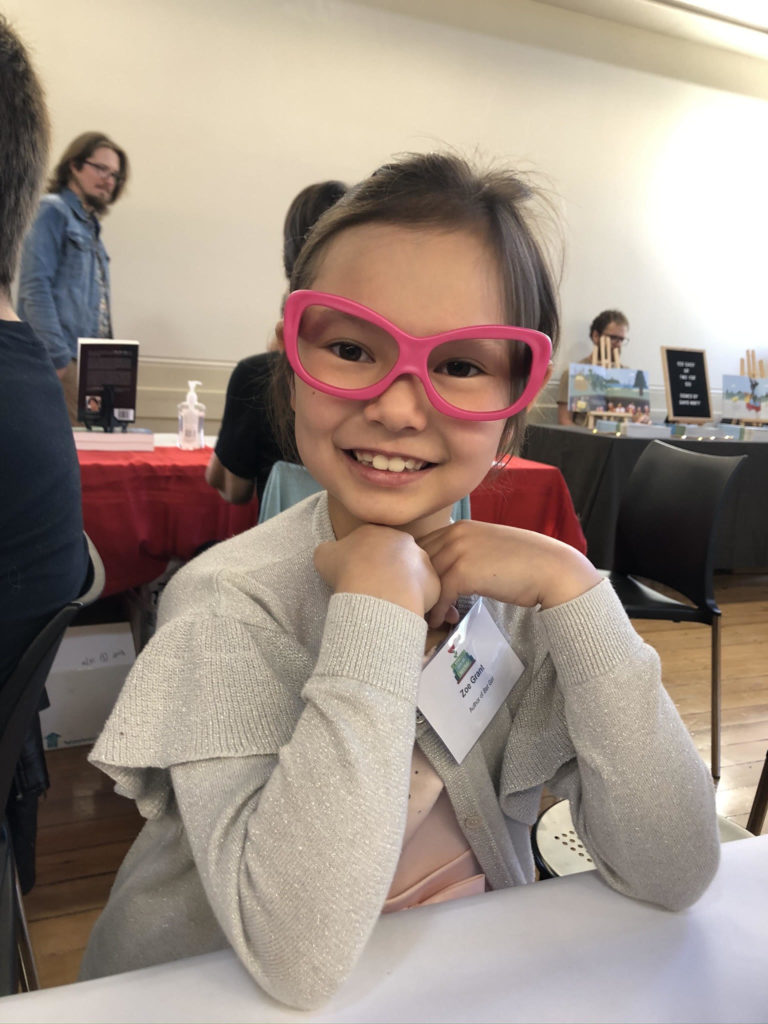
Zoe Grant is 7 years old, an award-winning haiku poet from Auckland, New Zealand. She loves ballet, karate, and music, especially the flute. Zoe writes poetry with her mother Sherry Grant. Together they published and launched their first poetry book Bat Girl in June 2021. The mother-daughter duet co-hosted “Rengay Under the Moon” gatherings online in September 2021, with Garry Gay (USA) and Kala Ramesh (India) as guest speakers. They were also guest poets in six radio and journal interviews hosted in four countries from April to November 2021. Zoe’s poems have been published in many journals such as Failed Haiku, Stardust Haiku, Haiku Dialogue, the Bamboo Hut, Brass Bell Journal, Kontinuum, and many other anthologies around the world, including the 2021 NZPS Anthology. Zoe is best known for her haiku, senryu, and rengay. She is also the co-editor of Chalk on the Walk Haiku and Chalk on the Walk Monoku journals on Facebook.
Zoe’s Webpage: www.artsinfinitypress.com/zoegrant
Facebook: Chalk on the Walk Haiku | Chalk on the Walk Monoku
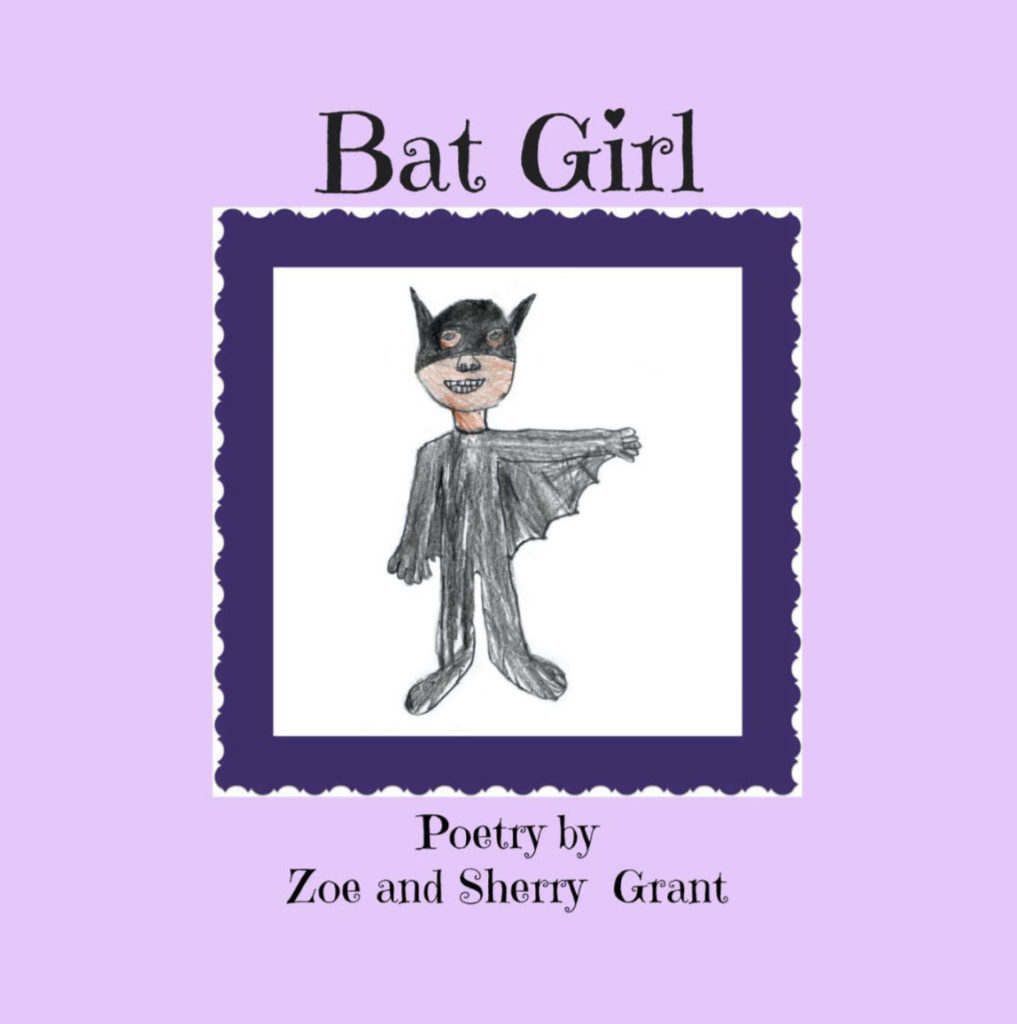
I first got inspired to write poetry by my mum who spends a lot of her time writing poems. We started our poetry writing journey together in June 2020. The idea of our first book ‘Bat Girl’ came from a Sunday morning, when I found my brother’s old Batman costume and put it on then jumped excitedly on my parents’ bed and convinced my mum to write a poem about it. We were learning about a kind of poem called gogyoshi at the time, so my mum took a photo of me and we wrote a gogyoshi together. Some of our poems are very funny and they rhymed, mostly about our family and kitten Cookie. Several of the poems are in the Japanese short form, like haiku, senryu, tanka, gogyoshi, and nonaku, a new short poetry form my mum invented in September 2020. We put the ‘Bat Girl’ book together within a week, with me illustrating for all of the poems including the cover after we decided to join an authors’ book event in Auckland, where authors came together at a market to sell their book publications. At first, we just printed the poems out and bound the books at home but half a year later we went to the book printer and got them made into pretty looking books, before the ‘Bat Girl’ book launch in June 2021, in which I performed ballet and my mum, my sisters and brother all performed music on different instruments. Purple is my and my mum’s favourite colour so the book cover for Bat Girl is purple, a big thank you to our editor friend Christine L. Villa (USA) for her help in improving the final look of the book. Soon we will also release it on Amazon as a book and e-book. ‘Bat Girl’ was written to inspire kids around the world to write poetry with their parents and grandparents, with their own illustrations.
scarecrow
I too stand
very still
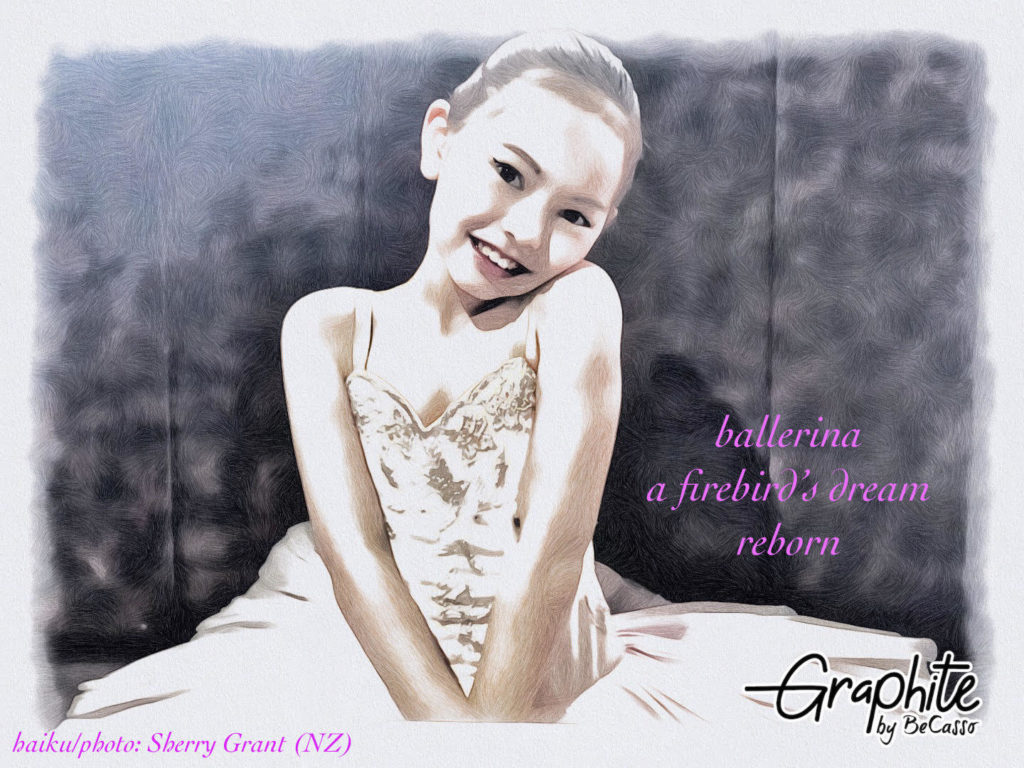
I went to my first ever ballet competition in July 2021. It’s always been my dream to become a ballerina. My mum took a lot of photos of me in my pretty pink tutu and wrote a haiku about a firebird, which is also her Chinese pen name (火の鳥). My mum and I later went to see the Royal New Zealand Ballet of ‘The Firebird’. We also drove to Tauranga for some haiku workshops for 3 days, just me and my mum. One of the workshops was in Katikati where there was a haiku park. After we walked through the Haiku Pathway at the park, we thought it would be so nice to see haiku in parks around Auckland too. Later on, we saw a post online about a boy chalking haiku on the sidewalk. I and my mum liked the idea very much, and since we were in the middle of a very long lockdown in Auckland, we ordered some normal chalk and some boxes of coloured chalk. At the end of August 2021, we started our “Chalk on the Walk Haiku” project! On the first day, my sister Rebecca helped me chalk my award-winning haiku at the 2021 NZPS International Haiku Competition (Junior School Section), and after that, we made sure that we chalk a haiku each day on our long sidewalk, or if it rains, we share a haiga instead. Soon Rebecca and I decided to start another Facebook group called “Chalk on the Walk Monoku” to share one-line haiku. I chalk with my mum these days and usually get photographed a lot on my scooter. We really enjoy illustrating to these great poems by our haiku friends from all over the world.
rain puddle
my cat jumps
over the rainbow
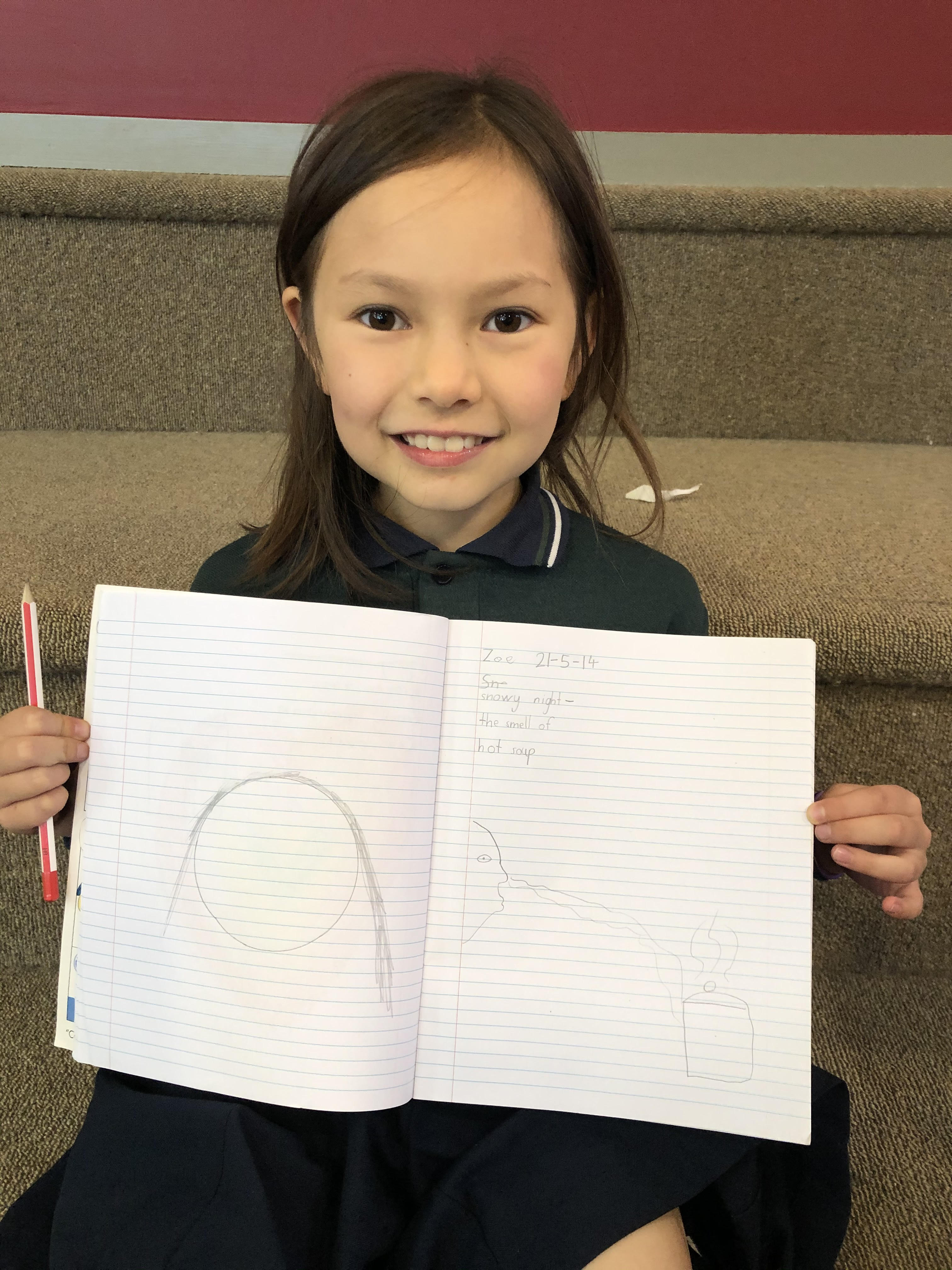
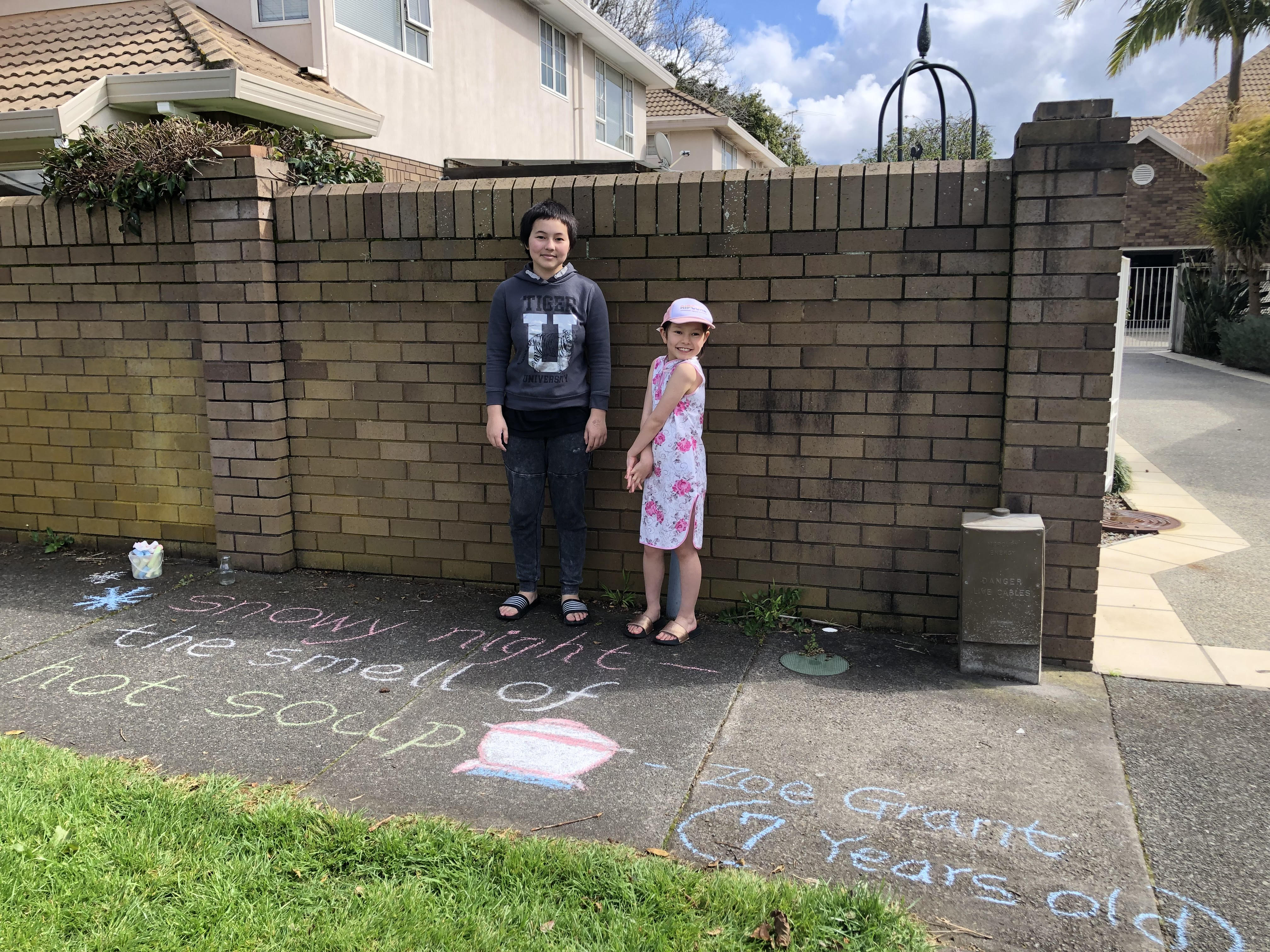
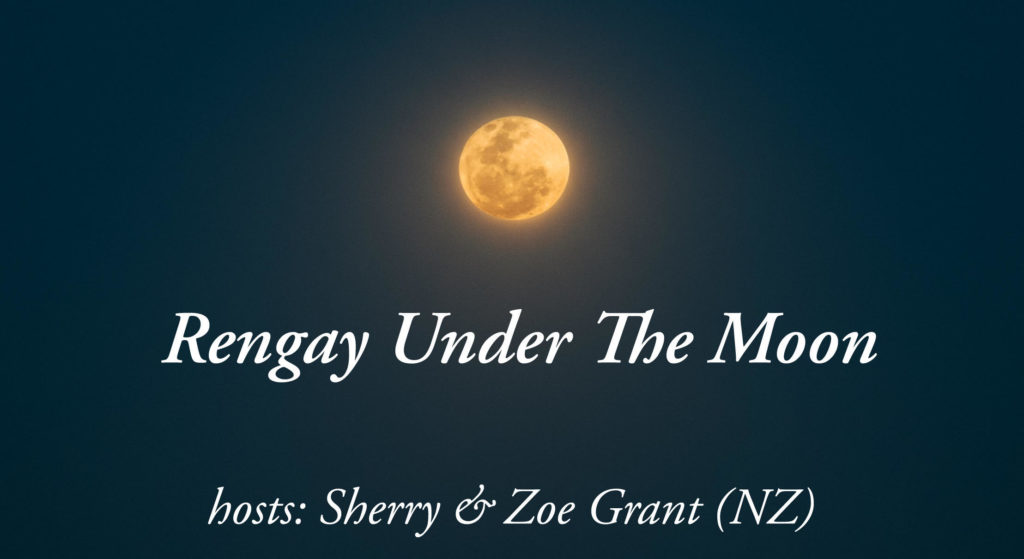
In September 2021, my mum organised a Rengay Under the Moon Gathering on a Sunday morning and afternoon. We invited lots of dear poet friends from all over the world to write rengay together. Our friends came from countries like NZ, Australia, India, America, Europe, and more. For the special speakers, we were very lucky to have Garry Gay (inventor of rengay) to join us, and Kala Ramesh who is also such a great haiku poet. I wrote my first rengay with my mum, just before her Haiku Society of America Rengay Workshop in June 2021. It was called “Dessert Time” and my mum used it in her rengay workshop presentation! She also showed her Chinese translation of it. After we wrote some more 2-person rengay, I didn’t write any 3-person rengay until a few days before co-hosting the Rengay Gatherings in September 2021. Ron C. Moss (Australia) was my first 3-person rengay writing partner, and after that my mum and I wrote many rengay with more friends in a very short time, to make sure I felt ready to co-host the rengay gathering! It was a very long day (9-11am and 2-4pm New Zealand time), but I stayed awake for all of it. A lot of my 3-person rengay have been published at different journals. Once I have written 50 rengay I will put them in a book to publish on Amazon. I am very close to this big goal!
origami
a pair of butterflies
flutter away
I am having so much fun writing poetry by myself, with my mum, and her poet friends. I’m also getting a lot of my poems published, I hope to inspire children around the world to write poetry as well! I know most kids like me will choose to watch TV or play games if they feel bored, but it is actually really good to be able to write down your ideas or keep a diary by writing poetry, and I feel very proud whenever my poems get published in a journal or anthology. In 2021 I was interviewed in four countries for my book ‘Bat Girl’ and that was very enjoyable. I got to read my poems on the radio shows. I am now also writing my own solo haiku books, and rengay books with my mum, I think I might be the youngest journal editor in the world (with Chalk on the Walk Haiku/Monoku), and the youngest person to have ever attended Haiku North America Virtual Conference (in October 2021) in the last 30 years. Later on I am planning to publish ‘Bat Girl’ also as an audio flipbook and make my own haiku podcast with my mum on YouTube, to share good poetry and teach more children to write haiku. Together my mum and I will start the nonaku journal, a new rengay annual anthology and run an annual rengay contest. I will teach kids’ haiku workshops sometimes too. I think everybody around the world should join us in our poetry revolution. Haiku is only 3 lines long and anyone should try it!
trapped
in the mug
gummy bears
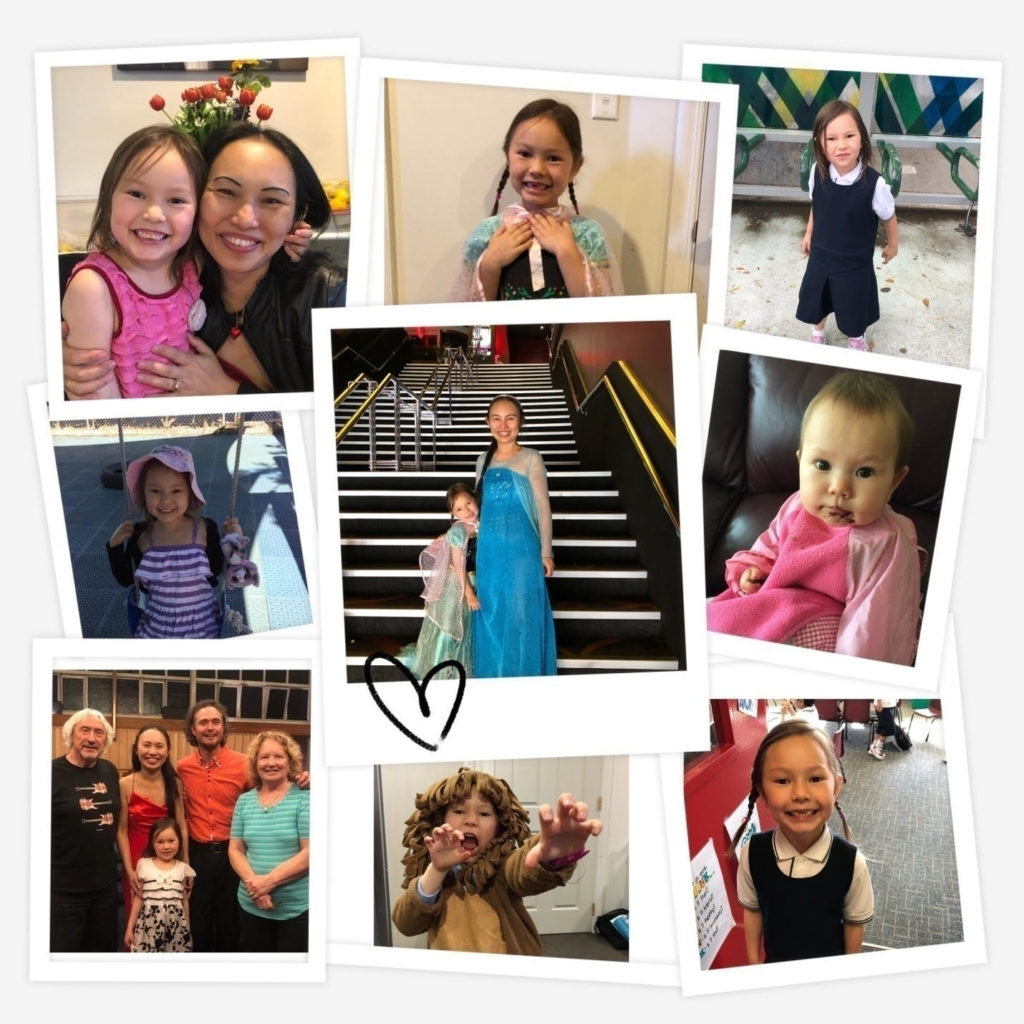
Note: This page is published with parental consent.
Last updated: 2022-01-13
![]()
![]()
